中文词条原文链接(无法从中国内地访问):点击这里访问。
英文词条原文链接(无法从中国内地访问):点击这里访问。
本文基于英文词条的线索,并补充部分来自中文词条的内容(在二者冲突时,以更晚更新者为准)。辽观搬运时进行了必要的合规化处理,以使其能够在中国内地上传。
维基百科(Wikipedia)是美国维基媒体基金会的互联网百科项目(点击这里了解更多),其内容可能受到立场、信息来源等因素影响,请客观看待。正文内容不代表译者观点。
辽观提供的翻译仅供参考。文中可能包含无法从中国内地访问的链接。
辽观所搬运的词条文本与原维基百科词条同样遵循CC-BY-SA 4.0协议,在符合协议要求的情况下您可以免费使用其内容(包括商用)。文中的图片可能遵循不同的共享协议:本文涉及到的共享协议
封面图片:Logo des Galileo Satellitennavigationsprojekts(Galileo卫星导航项目的标志)原图链接 此图片属于公共领域
目录
- 0. 概述
- 1. 历史 | History
- 2. 时钟故障 | Clock failures
- 3. 国际参与 | International involvement
- 4. 系统描述 | System description
- 5. 欧洲GNSS服务中心 | European GNSS Service Centre
- 6. 搜救 | Search and rescue
- 7. 卫星星座 | Constellation
- 8. 应用和影响 | Applications and impact
- 9. 参见(相关词条)See also
- 10. 文献
- 12. 外部链接 External Links
0. 概述
辽观注:此标题是我们在搬运、整合过程中添加的。
Galileo is a global navigation satellite system (GNSS) that went live in 2016,[5] created by the European Union through the European Space Agency (ESA), operated by the European Union Agency for the Space Programme (EUSPA),[6] headquartered in Prague, Czechia,[7] with two ground operations centres in Fucino, Italy, and Oberpfaffenhofen, Germany. The €10 billion project[4][8] is named after the Italian astronomer Galileo Galilei. One of the aims of Galileo is to provide an independent high-precision positioning system so European political and military authorities do not have to rely on the US GPS, or the Russian GLONASS systems, which could be disabled or degraded by their operators at any time.[9] The use of basic (lower-precision) Galileo services is free and open to everyone. A fully encrypted higher-precision service is available for free to government-authorized users.[10][11] Galileo is intended to provide horizontal and vertical position measurements within 1 m precision. Galileo is also to provide a new global search and rescue (SAR) function as part of the MEOSAR system.
参考译文:Galileo是一个全球卫星导航系统(GNSS),于2016年开始运行,由欧洲联盟通过欧洲航天局(ESA)创建,由欧洲空间计划机构(EUSPA)运营,总部位于捷克布拉格,在意大利Fucino和德国Oberpfaffenhofen设有两个地面运营中心。这个耗资100亿欧元的项目以意大利天文学家伽利略·伽利莱命名。Galileo的一个目标是提供一个独立的高精度定位系统,使欧洲的政治和军事机构不必依赖美国的GPS或俄罗斯的GLONASS系统,因为这些系统可能随时被其运营商禁用或降级。基本的Galileo服务是免费对所有人开放的。完全加密的高精度服务则只对经政府授权的用户免费提供。Galileo旨在提供1米精度的水平和垂直位置测量。同时,Galileo还将作为MEOSAR系统的一部分提供全球搜索和救援(SAR)功能。
伽利略系统是中地球轨道搜救卫星系统的一部分,可提供一种新的全球搜救方式。伽利略系统的卫星安装有转发器,可以把求救信号从事故地点发送到救援协调中心,救援协调中心就会开始组织救援。同时,该系统还会发射一个返回信号到事故地点处,通知求救人员他们的信号已被收到,相应的救援也正在展开。现有的全球卫星搜救系统是不具备反馈信号功能的,所以伽利略系统这个发消息功能被认为是对全球卫星搜救系统的一个重要升级。[6]2014年,研究人员对伽利略系统的搜救功能进行了测试,该系统是作为当时的全球卫星搜救系统的一部分工作的,测试结果显示,该系统对77%的模拟求救位置定位精度在2千米以内,95%的求救位置定位精度在5千米以内。[7]
The first Galileo test satellite, the GIOVE-A, was launched 28 December 2005, while the first satellite to be part of the operational system was launched on 21 October 2011. By July 2018, 26 of the planned 30 active satellites (including spares) were in orbit.[12][13] Galileo started offering Early Operational Capability (EOC) on 15 December 2016,[1] providing initial services with a weak signal, and was expected to reach Full Operational Capability (FOC) in 2022.[14] The full Galileo constellation will consist of 24 active satellites,[15] which is expected by 2021.[16] It is expected that the next generation of satellites will begin to become operational after 2025 to replace older equipment, which can then be used for backup capabilities.
参考译文:第一颗Galileo测试卫星GIOVE-A于2005年12月28日发射,而第一颗作为操作系统一部分的卫星于2011年10月21日发射。截至2018年7月,计划中的30颗活动卫星(包括备用卫星)中有26颗已经进入轨道。Galileo于2016年12月15日开始提供初步运行能力(EOC),提供弱信号的初始服务,并预计在2022年达到全面运行能力(FOC)。完整的Galileo星座将包括24颗活动卫星,预计将在2021年实现。预计下一代卫星将在2025年后开始投入运行,以取代老旧设备,而老旧设备则可以用于备份能力。
As of May 2023, there are 23 launched satellites that operate in the constellation. The two GIOVE prototype satellites were retired in 2012, one satellite is not available, and four satellites are currently not usable.[17] Out of 23 active satellites, three were from the IOV (In-Orbit Validation) types and 20 of the FOC types. The first pair of FOC satellites are orbiting the Earth in eccentric incorrect orbits whose orientation changes with respect to other Galileo orbital planes.[18][19] The Galileo system has a greater accuracy than GPS, having an accuracy of less than 1 m when using broadcast ephemeris (GPS: 3 m)[20] and a signal-in-space ranging error (SISRE) of 1.6 cm (GPS: 2.3 cm, GLONASS and BeiDou: 4–6 cm) when using real-time corrections for satellite orbits and clocks.[21][22]
参考译文:截至2023年5月,Galileo星座中有23颗卫星正在运行。两颗GIOVE原型卫星于2012年退役,一颗卫星不可用,还有四颗卫星目前无法使用。在这23颗活动卫星中,三颗是IOV(在轨验证)类型,20颗是FOC(全面运行能力)类型。第一对FOC卫星正在绕地球运行,其轨道高度不正确且离心率不正常,其方向与其他Galileo轨道平面有所变化。Galileo系统的精度比GPS更高,使用广播星历时的精度小于1米(GPS:3米),使用实时修正的卫星轨道和钟差时,信号在空间距离测量中的误差为1.6厘米(GPS:2.3厘米,GLONASS和BeiDou:4-6厘米)。
基本信息
| 国家或地区 | 欧盟 |
| 运行组织 | 欧洲导航卫星系统管理局(EUSPA) 欧洲空间局(ESA) |
| 类型 | 民用,商用 |
| 状态 | 已激活 |
| 覆盖范围 | 全球 |
| 精度 | 20 cm (public since 24 January 2023) 20cm(2023年1月24日公开) |
| 造价 | 100亿欧元[2] |
| 网站 | Website | gsc-europa.eu (European GNSS Service Centre) gsc-europa。欧洲全球导航卫星系统服务中心 |
卫星星座规模 | Constellation size
| 卫星总数 | 30 |
| 在轨卫星数量 | 23 usable, 1 not available, 4 not usable (09/2022)[2] 23个可用,1个不可用,4个不可用(09/2022) |
| 首次发射 | 2011 |
| 已发射数量 | 28,不包括2枚试验卫星(2023年5月)[1] |
轨道特征 | Orbital characteristics
| 轨道构型 | Regime(s) | 3个 中地球轨道 平面 | 3 × MEO planes |
| 轨道高度 | Orbital height | 23222 km |
1. 历史 | History

图片题注:The headquarters of the EUSPA, which operates the Galileo system, in Prague(欧洲空间计划机构(EUSPA)负责运营Galileo系统,其总部位于布拉格。)
图片作者:MirkoS18
1.1 主要目标 | Main objectives
伽利略系统的的三大投资方(德国、法国和意大利)[11]对该系统的发展提出了不同的目标。1999年,这些目标被这三国工程师组成的联合小组精简为一个。2003年5月26日,欧盟和欧洲空间局正式批准了这个项目的第一阶段计划。伽利略系统主要用于民用,而美国的全球定位系统、俄罗斯的格洛纳斯系统和中国的北斗系统更加偏向军事用途。伽利略系统仅仅在一些极端情况下才会因为军事目的而关闭(比如武装冲突[12])。对于军用和民用终端来说,该系统都提供最高的定位精度。
Italy and Germany led the development of the first generation of the Galileo program,[25] while France is playing a more prominent role in the development of the Galileo Second Generation (G2G).[26][27][28]
参考译文:意大利和德国主导了第一代Galileo计划的开发,而法国在Galileo第二代(G2G)的开发中发挥了更重要的作用。
1.2 资金来源 | Funding
2001年11月,有几份据称是该项目“年度”销售预测的表格被揭发,它们实际上是“累计”销售预测,所谓的年销售额实际上包含了以往年份的销售总额。然后,欧盟委员会对伽利略系统下一阶段的投资遇到了麻烦。人们对这个高达数十亿欧元的预测错误的关注,引发了欧盟委员会和其他相关组织普遍的担忧,人们开始怀疑伽利略系统并不能产生之前向投资者和决策者预示的那么多收益[13]。2002年1月17日,伽利略系统的一名发言人表示,由于美国的压力以及经济问题,伽利略系统的计划“接近死亡”[14]。
然而,几个月后事情出现了转机。欧盟成员国认为,在政治冲突中拥有一个不会被美国轻易关闭的卫星定位授时系统是很重要的[15]。
欧盟与欧洲空间局于2002年3月同意为该计划注资,并计划于2003年审核该报告(最终于2003年5月26日完成)。按计划,这一阶段持续到2005年,需要的初始投资预估为11亿欧元。该项目所需的卫星(需30颗)计划于2011年至2014年之间发射,并开始建造、运行该系统,最终于2019年转为民间控制。这份报告预估伽利略系统最终将花费30亿欧元,这包括了地球上的基础设施,它们将于2006年至2007年间建造完成。按照这份投资计划,三分之二的资金来自私人企业及个人投资,剩下的部分由欧盟和欧洲空间局来承担。伽利略系统的开放服务提供给所有安装有用户免费使用,只需要用户安装一个兼容的接收器即可。付费用户可以使用经过加密的大宽带高精度商务服务。到了2011年初,该项目的实际花费已超出了最初预算的50%[16]。
德国航空航天中心对伽利略系统的注资是最多的,它位于诺伊斯特雷利茨的地球观测中心、通信与导航研究院对伽利略系统的研发与应用是至关重要的。[17]
1.3 与美国的紧张关系 | Tension with the United States
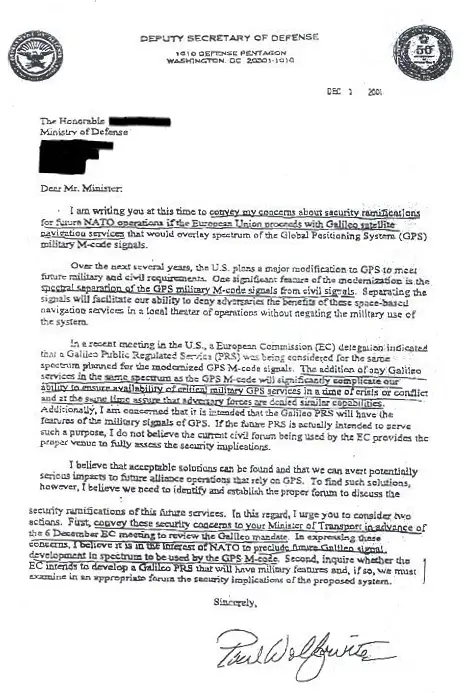
图片题注:美国国防部副部长保罗·沃尔福威茨于2001年12月写给欧盟成员国部长的一封信,表达了美国对伽利略系统的反对态度。
图片来源:Paul Wolfowitz
欧盟的伽利略系统旨在建立一个向所有用户开放的民用全球卫星导航系统。GPS是美国的军用全球卫星导航系统,为美国军事用户提供高精度的定位服务,同时也为其他用户提供低精度定位服务。GPS可以在其军用信号(M波段)不被干扰的情况下关闭民用信号。建造伽利略系统的一个初衷便是欧盟担心美国会在政治冲突中禁止其他用户使用GPS信号。[15]
伽利略系统的目的是为所有用户提供尽可能高的定位精度(比GPS还高),因此,美国担心其敌人会利用伽利略系统的信号对美国及其盟友进行军事打击(一些武器使用卫星导航系统进行制导)。伽利略系统最初选用的频率使得美国无法在不干扰GPS信号的的情况下屏蔽掉伽利略系统。美国打算在阻止敌人使用卫星导航系统(GNSS)的同时自己依然能使用GPS。当有报道指出中国对伽利略系统也很有兴趣后,美国官方对此更是担忧。[18]
一名不愿透露姓名的欧盟官员称,美国官员暗示,如果敌人在冲突中使用装备了伽利略系统的武器攻击美军,美国也许会考虑击落伽利略卫星[19]。欧盟的立场是,伽利略定位系统是中立的技术,可以被任何国家、个人使用。开始时,欧盟官方并不想改变伽利略系统的计划,但是最终还是达成了妥协,伽利略系统改用另一种频率。这将使得对一个系统的屏蔽不会影响到另一个系统(屏蔽伽利略系统的同时不影响GPS,或者屏蔽GPS不影响伽利略),这使得美国在冲突中拥有巨大的优势,因为他们的电子战能力占优势[20]。
1.4 GPS和伽利略系统比较 | GPS and Galileo
图片题注:Orbit size comparison of GPS, GLONASS, Galileo, BeiDou-2, and Iridium constellations, the International Space Station, the Hubble Space Telescope, and geostationary orbit (and its graveyard orbit), with the Van Allen radiation belts and the Earth to scale.[a] The Moon‘s orbit is around 9 times as large as geostationary orbit.[b] (In the SVG file, hover over an orbit or its label to highlight it; click to load its article.)
图片作者:cmglee
参考译文:GPS、GLONASS、Galileo、BeiDou-2和Iridium星座的轨道大小比较,国际空间站、哈勃太空望远镜以及地球同步轨道(及其墓地轨道)与范艾伦辐射带的比例尺。[a]月球的轨道大约是地球同步轨道的9倍。[b](在SVG文件中,将鼠标悬停在轨道或其标签上以突出显示;点击加载其文章。)
应美国军方的要求,GPS使用了选择可用性机制,其定位信息被故意加入了误差,这是欧盟意图独立发展伽利略系统的一个原因。GPS在全球范围内广泛用于民用,包括飞机导航和着陆设备,伽利略系统的支持者认为这些民用设施不能完全依赖于一个有漏洞的系统。
2000年5月2日,时任美国总统比尔·克林顿停止了GPS的选择可用性机制。2001年底,管理GPS的机构证实他们将不再启用选择可用性机制[21]。但这时的GPS系统仍然具备选择可用性能力,到2007年9月19日,美国国防部宣布,新的GPS卫星不再具备实施选择可用性机制的能力[22];声明称,将于2009年发射的Block IIF系列卫星,以及后续的所有GPS卫星都不支持选择可用性机制。所有的老式卫星将在Block IIIA计划中被替换掉,届时,GPS将再也不能实施选择可用性机制。这个现代化的项目包含了一些标准化的功能,使得第三代GPS能和伽利略系统合作工作,另外,利用这些标准可以开发出同时使用GPS和伽利略系统的定位终端,这将构建出一个更加精确的全球卫星导航系统。
One of the reasons given for developing Galileo as an independent system was that position information from GPS can be made significantly inaccurate by the deliberate application of universal selective availability (SA) by the US military. GPS is widely used worldwide for civilian applications; Galileo’s proponents argued that civil infrastructure, including aircraft navigation and landing, should not rely solely upon a system with this vulnerability.
参考译文:开发独立的伽利略系统的原因之一是,美军故意应用普遍选择性可用性(SA)可以使GPS的位置信息显著不准确。GPS在全球范围广泛应用于民用应用,伽利略的支持者认为,民用基础设施,包括飞机导航和着陆,不应仅仅依赖于一个存在这种脆弱性的系统。
On 2 May 2000, the selective availability was disabled by the President of the United States, Bill Clinton; in late 2001 the entity managing the GPS confirmed that it did not intend to enable selective availability ever again.[38] Though Selective Availability capability still exists, on 19 September 2007 the US Department of Defense announced that newer GPS satellites would not be capable of implementing Selective Availability;[39] the wave of Block IIF satellites launched in 2009, and all subsequent GPS satellites, are stated not to support selective availability. As old satellites are replaced in the GPS Block III programme, selective availability will cease to be an option.[40] The modernisation programme also contains standardised features that allow GPS III and Galileo systems to inter-operate, allowing receivers to be developed to utilise GPS and Galileo together to create an even more accurate GNSS.
参考译文:2000年5月2日,美国总统比尔·克林顿停用了普遍选择性可用性。2001年末,负责管理GPS的机构确认他们不再打算再次启用普遍选择性可用性。尽管普遍选择性可用性的能力仍然存在,但2007年9月19日,美国国防部宣布新的GPS卫星将不再具备实施普遍选择性可用性的能力。2009年开始发射的Block IIF卫星及其后续GPS卫星都不支持普遍选择性可用性。随着GPS Block III计划中旧卫星的替换,普遍选择性可用性将不再是一个选项。现代化计划还包括标准化功能,允许GPS III和伽利略系统进行互操作,使接收器能够同时利用GPS和伽利略来创建更精确的全球导航卫星系统。
1.5 与美国的合作 | Cooperation with the United States
2004年6月,欧盟与美国签署了协议,同意在伽利略系统中使用“二进制偏置载频1.1”标准,就此GPS和伽利略系统互相兼容合,这也使得人们有可能在将来同时使用这两个系统进行定位。
The European Union also agreed to address the “mutual concerns related to the protection of allied and US national security capabilities”.[24]
参考译文:欧盟还同意解决与”保护盟国和美国国家安全能力相关的共同关切”的问题。
1.6 首批试验卫星 | First experimental satellites: GIOVE-A and GIOVE-B
伽利略系统的第一颗试验卫星GIOVE-A于2005年12月发射,随后,第二颗测试卫星GIOVE-B于2008年4月发射。在轨验证阶段完成后,有更多的卫星被发射升空。2007年11月30日,来自欧盟成员国的27个交通部长达成协议,伽利略系统将在2013年投入运营[23],但是,会后的新闻稿表明,它将被推迟到2014年[24]。
1.7 再次资助,及管理问题 | Funding again, governance issues
2006年中,为伽利略系统注资的政府社会资本共同体瓦解,欧盟委员会决定将伽利略系统国有化[25]。
2007年年初,欧盟还未决定如何负担这个项目的经费,据说伽利略系统由于缺乏公共经费支持陷入了“深层次的危机”。当时只有一颗测试卫星被发射升空,德国交通部长Wolfgang Tiefensee特别担忧财团在争论中结束该项目[26]。
2007年6月13日,欧盟讨论了一个方案,在下一年从相互竞争的经费中削减出五亿四千八百万欧元来用到其他财政项目上[27],此举将有可能部分满足伽利略导航系统的开支。欧盟的研究与开发计划有可能因为经费短缺而被终止。
2007年11月,欧盟同意将从农业和行政预算中重新分配资金[28],以降低招标标准来邀请更多的企业来投资伽利略系统[29]。
2008年4月,欧盟的交通部长批准了伽利略系统实施条例。这使得欧盟从农业和行政预算中拨款34亿欧元用来招标[30],以启动地面站和卫星的建设。
2009年6月,欧洲审计院发布的一份报告指出,管理不力、严重拖延和预算超支这些问题,导致了项目于2007年停摆,并导致了进一步的延迟和失败[31]。
In October 2009, the European Commission cut the number of satellites definitively planned from 28 to 22, with plans to order the remaining six at a later time. It also announced that the first OS, PRS and SoL signal would be available in 2013, and the CS and SOL some time later. The €3.4 billion budget for the 2006–2013 period was considered insufficient.[50]
参考译文:在2009年10月,欧洲委员会决定将伽利略系统计划的卫星数量从28颗减少到22颗,并计划在以后的时间里订购剩余的六颗卫星。同时,他们宣布第一批运营信号包括开放服务(OS)、公共监控服务(PRS)和搜索与救援信号(SoL)将在2013年可用,商业服务(CS)和安全服务(SoL)稍后推出。然而,预算为2006年至2013年期间的34亿欧元被认为是不足的。
2010年,智库“开放欧洲”估计,伽利略系统从启动到建成后20年的花费共计222亿欧元,这些经费将完全由纳税人来承担。根据原先在2000年做出的估算,该系统将花费77亿欧元,纳税人承担其中的26亿,其余由私人投资者承担[32]。
In November 2009, a ground station for Galileo was inaugurated near Kourou (French Guiana).[52] The launch of the first four in-orbit validation (IOV) satellites was planned for the second half of 2011, and the launch of full operational capability (FOC) satellites was planned to start in late 2012.
参考译文: 在2009年11月,位于库鲁(法属圭亚那)附近的一座伽利略地面站正式揭幕。首批四颗轨道验证(IOV)卫星计划于2011年下半年发射,全面运行能力(FOC)卫星计划于2012年底开始发射。
按计划,前四颗“在轨验证卫星”(IOV)将于2011年下半年发射,“完全运行能力卫星”(FOC)将于2012年年末发射。
2010年3月,据证实,由于伽利略系统的经费有限,到2014年最多能提供4颗“在轨验证卫星”和14颗“完全能力卫星”。有人提议就使用这18颗卫星组网,对此,欧盟委员会卫星导航项目的主管Paul Verhoef举了个例子来说明经费短缺的后果有多严重:“直观的说,在这种情况下,一年中将有3个星期没有导航信号”。
2010年7月,欧盟委员会评估,伽利略项目的额外费用将上升到15亿至17亿欧元,项目的建成日期要推迟到2018年。伽利略系统建成后,政府每年还需要补贴7.5亿欧元[34]。另外,还需19亿欧元将卫星数量补充到30颗(27颗工作卫星,3颗备用卫星)[16][35]。
2010年12月,欧盟部长在布鲁塞尔举行投票,将捷克共和国的布拉格作为伽利略系统的总部[36]。
2011年1月,据估计,截止2020年各项基础设施的花费将达到53亿欧元。就在这个月,维基解密透露,德国卫星公司OHB-System的CEO,Berry Smutny说伽利略系统“是一个主要服务法国利益的愚蠢计划”[37]。BBC获悉,2011年伽利略系统将获得5亿欧元用于采购,使用数年时间将18颗工作卫星增加为24颗[38]。
2011年10月21日,伽利略的前两颗在轨验证卫星由联盟ST-B火箭在圭亚那航天中心发射[39] ,另外两颗于2012年10月12日发射。[40]
另外22颗“完全能力卫星”从2012年开始采购,其中的前四对卫星分别于2014年8月22日,2015年3月27日,2015年9月11日,2015年12月17日发射[41]。
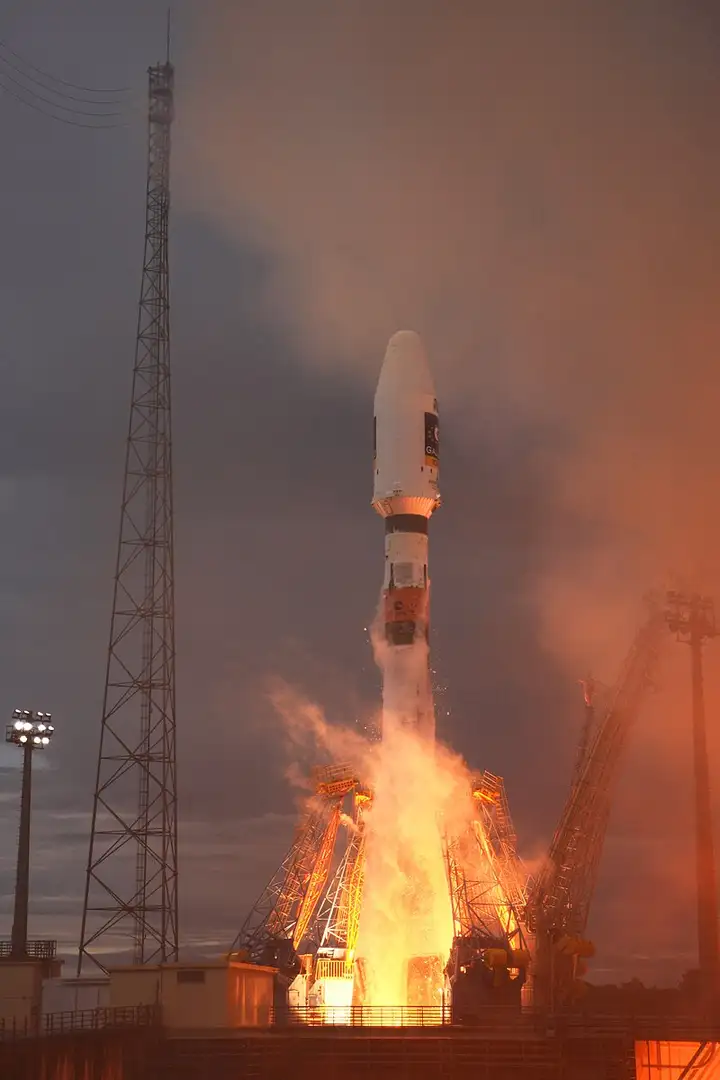
2011年10月21日,一枚由联盟号火箭有效载荷的伽利略卫星在圭亚那航天中心发射。
图片来源:Thilo Kranz/DLR
首七次发射(L1到L7)均由联盟ST-B火箭执行,每次发射两枚卫星。其中,第三次发射失败,卫星未有进入正确的轨道。从第八次任务(L8)开始,欧洲空间局改用阿丽亚娜5型执行发射任务,每次发射四枚卫星,L8到L10全部发射成功。L11将改用研发中的阿丽亚娜6型执行,每次发射两枚卫星。
2011年10月21日,第一组实验卫星IOV PFM和FM2发射入轨成功。
2012年10月12日,第二组实验卫星IOV FM3和FM4发射入轨成功。
2014年8月22日,第三组卫星FOC FM1和FM2发射成功,但未正确入轨。卫星发射到离地面高度25900km,但其后跌至13713km。由于卫星上的燃料不足以完全修正轨道,欧洲空间局只能把两枚卫星调整到半径27977.6km,离心率0.162的椭圆形“扩展轨道”,用作测试用途。正常的轨道半径是29599.8km,离心率为0。
The first two Galileo In-Orbit Validation satellites were launched by Soyuz ST-B flown from Centre Spatial Guyanais on 21 October 2011,[59] and the remaining two on 12 October 2012.[60] As of 2017, the satellites are fully useful for precise positioning and geodesy with a limited usability in navigation.[61]
参考译文:伽利略系统的首批两颗轨道验证卫星于2011年10月21日由从法属圭亚那的库鲁航天中心发射的Soyuz ST-B火箭搭载。剩下的两颗卫星于2012年10月12日发射。截至2017年,这些卫星已经完全可用于精确定位和大地测量,但在导航方面的可用性有限。
Twenty-two further satellites with Full Operational Capability (FOC) were on order as of 1 January 2018. The first four pairs of satellites were launched on 22 August 2014, 27 March 2015, 11 September 2015 and 17 December 2015.[62]
参考译文:截至2018年1月1日,还有22颗全面运行能力(FOC)的卫星在订购中。第批四对卫星分别于2014年8月22日、2015年3月27日、2015年9月11日和2015年12月17日发射。
2. 时钟故障 | Clock failures
In January 2017, news agencies reported that six of the passive hydrogen masers (PHM) and three of the rubidium atomic clocks (RAFS) had failed. Four of the full operational satellites have each lost at least one clock; but no satellite has lost more than two. The operation has not been affected as each satellite is launched with four clocks (2 PHM and 2 RAFS). The possibility of a systemic flaw is being considered.[63][64][65] SpectraTime, the Swiss producer of both on-board clock types, declined to comment.[66] According to ESA, they concluded with their industrial partners for the rubidium atomic clocks that some implemented testing and operational measures were required. Additionally some refurbishment is required for the rubidium atomic clocks that still have to be launched. For the passive hydrogen masers operational measures are being studied to reduce the risk of failure.[63] China and India use the same SpectraTime-built atomic clocks in their satellite navigation systems. ESA has contacted the Indian Space Research Organisation (ISRO) who initially reported not having experienced similar failures.[66][65] However, at the end of January 2017, Indian news outlets reported that all three clocks aboard the IRNSS-1A satellite (launched in July 2013 with a 10-year life expectancy) had failed and that a replacement satellite would be launched in the second half of 2017: these atomic clocks were said to be supplied under a four-million-euro deal.[67][68][69][70]
参考译文:据2017年1月的新闻报道,有6台被动氢质子谐振器(PHM)和3台铷原子钟(RAFS)发生故障。其中4颗全面运行的卫星中至少有一台钟表出现问题,但没有一颗卫星丢失超过两个钟表。由于每颗卫星发射时都携带有4个钟表(2个PHM和2个RAFS),因此运行并未受到影响。目前正在考虑是否存在系统性缺陷的可能性。同时,瑞士的钟表生产商SpectraTime拒绝置评。据欧洲航天局(ESA)表示,他们与铷原子钟的工业合作伙伴达成了结论,认为需要采取一些测试和操作措施。此外,仍需对尚未发射的铷原子钟进行一些翻新工作。对于被动氢质子谐振器,正在研究采取操作措施以减少故障风险。中国和印度在其卫星导航系统中使用了同样由SpectraTime制造的原子钟。欧洲航天局已与度空间研究组织(ISRO)取得联系,ISRO最初报告称没有经历类似的故障。然而,截至2017年1月底,印度新闻媒体报道称,IRNSS-1A卫星上的三个钟表(该卫星于2013年7月发射,寿命为10年)全部发生故障,一颗替代卫星将在2017年下半年发射:据称这些原子钟是在一项价值400万欧元的交易中提供的。
In July 2017, the European Commission reported that the main causes of the malfunctions have been identified and measures have been put in place to reduce the possibility of further malfunctions of the satellites already in space.[71][72] According to European sources, ESA took measures to correct both identified sets of problems by replacing a faulty component that can cause a short circuit in the rubidium clocks and improve the passive hydrogen maser clocks as well on satellites still to be launched.[73]
参考译文:根据2017年7月的欧洲委员会报告,对故障的主要原因已经找到,并采取了措施来减少已经在太空中的卫星进一步发生故障的可能性。根据欧洲消息来源,欧洲航天局(ESA)已经采取了措施来纠正这两组已经确定的问题,通过更换可能导致铷钟短路的故障组件,并改进了尚未发射的被动氢质子谐振器钟表。
2.1 停机 | Outages
2019
2019年7月11日至18日期间,伽利略系统失效,所有卫星信号中断。官方网站显示所有卫星不可用(NOT USABLE)。[42]消息指,事件是由于地面的精确计时设备故障,导致系统无法计算卫星的位置及时间。
2020
2020年12月14日,伽利略系统发生持续6小时的严重故障。[43]事件起因是地面的精确计时设备出现异常,令定位误差上升至80千米。
The problem was related to an abnormal behaviour of a ground segment atomic clock in the time determination function of the system. In the parallel functioning Precise Timing Facilities in the Fucino and Oberpfaffenhofen Galileo Control Centres an issue occurred in Fucino whilst maintenance was performed on the parallel system in Oberpfaffenhofen.[79]
参考译文:该问题与地面段原子钟在系统的时间确定功能中出现异常行为有关。在富奇诺和奥伯普法芬霍芬的伽利略控制中心的并行运行的精确定时设施中,在奥伯普法芬霍芬进行并行系统维护时,富奇诺出现了问题。
3. 国际参与 | International involvement
2003年9月,中国加入了伽利略计划,并将以后为该项目投资2.3亿欧元(约合23.4亿元人民币)[44]。
2004年7月,以色列与欧盟签订了协议,成为了伽利略系统的合作伙伴。
2005年6月3日,据报道,欧盟与乌克兰签署了一份协议,乌克兰也加入到了伽利略计划。
2005年9月7日,印度也与欧盟签约,加入“伽利略计划”,参与建设基于欧洲地球同步卫星导航增强服务系统的区域增强系统[45]。
2005年12月,摩洛哥加入了伽利略计划。
In mid-2006, the public–private partnership fell apart and the European Commission decided to nationalise Galileo as an EU programme.[43]
参考译文:在2006年中期,公私合作伙伴关系破裂,欧洲委员会决定将伽利略国有化,作为欧盟的一个计划。
2006年9月9日,韩国同欧盟签订了有关韩国参与伽利略计划的协定[46]。
2006年12月,中国选择独立自主开发北斗导航系统。 [47]早期,伽利略系统被看作是一个政府财政参与的私营项目,项目主管积极邀请中国加入,这样在短期内可以获得中国的投资,从长远看还能在中国的定位授时市场获得独特优势。然而,由于欧盟委员会的安全与技术独立性政策,中国实际上被伽利略系统排除在外,中国之前的投资也没有得到任何回报。这促使中国决定建设自己的全球定位系统——北斗卫星导航系统。
2006年12月12日,欧盟与摩洛哥签署了伽利略计划的合作协议[48]。
2007年11月30日,欧盟的27个成员国一致同意将推进伽利略项目的建设,该计划基于德国和意大利提出的方案。在第一轮投票中,西班牙并不赞成该方案,但在当天的晚些时候还是批准了。这次会议大大提高了伽利略项目的可行性,欧盟执行委员会曾经说过:如果到2008年1月还未就伽利略系统达成任何协议,那么这个陷入长期困扰的项目实际上将会终结。[49]
2009年4月3日,挪威也加入了伽利略项目,承诺将投入6980万欧元用于开发,并允许本国的企业投标建设合同。尽管挪威不是欧盟的成员,但其是欧空局的成员。[50]
2013年12月18日,瑞士签署了一份合作协议,全面参与伽利略计划,并为2008年到2013年之间的费用补交了8000万欧元。作为欧空局的成员,瑞士之前已经参与了伽利略项目,提供了本国最先进的氢微波激射器时钟。在加入欧盟研究框架后,瑞士在2014到2020年之间承担的财政将根据标准公式来计算。[51]
除此之外,不少国家如阿根廷、澳大利亚、巴西、加拿大、智利、日本、马来西亚、墨西哥、巴基斯坦、俄罗斯等,也有可能加入“伽利略计划”。[来源请求]
In March 2018, the European Commission announced that the United Kingdom may be excluded from parts of the project (especially relating to the secured service PRS) following its exit from the European Union (EU). As a result, Airbus was to relocate work on the Ground Control Segment (GCS) from its Portsmouth premises to an EU state.[4] British officials have been reported to be seeking legal advice on whether they can reclaim the €1.4 billion invested by the United Kingdom, of the €10 billion spent to date.[90] In a speech at the EU Institute for Security Studies conference, the EU Chief Negotiator in charge of the Brexit negotiations, Michel Barnier, stressed the EU position that the UK had decided to leave the EU and thus all EU programmes, including Galileo.[91] In August 2018, the UK stated that it would look into creating a competing satellite navigation system to Galileo post-Brexit.[92] In December 2018, British Prime Minister Theresa May announced that the UK would no longer seek to reclaim the investment, and Science Minister Sam Gyimah resigned over the matter.[93]
参考译文:2018年3月,欧洲委员会宣布英国可能在退出欧盟后被排除在伽略项目的某些分(特别是与安全服务PRS有关)。因此,空中客车公司将把地面控制段(GCS)的工作从其朴茨茅斯设施转移到欧盟成员国。据报道,英国官员一直在寻求法律意见,他们是否可以收回英国投资的14亿欧元,而迄今为止已经花费了100亿欧元。在欧盟安全研究所会议上的一次讲话中,负责脱欧谈判的欧盟首席谈判代表米歇尔·巴尼耶强调了欧盟的立场,即英国已经决定离开欧盟,因此包括伽利略在内的所有欧盟计划都不再适用于英国。2018年8月,英国表示将考虑在脱欧后建立一个与伽利略竞争的卫星导航系统。2018年12月,英国首相特蕾莎·梅宣布英国将不再寻求收回投资,并且科学部长萨姆·吉马因此事辞职。
4. 系统描述 | System description
每颗卫星都有两个铷原子钟和两个被动氢原子微波激射器时钟,它们对于卫星导航系统是至关重要的,另外伽利略卫星还包括一系列其他组件。这些时钟将提供精确的时间信号,可以计算出这些信号从发出到接收花费了多长时间。利用不同卫星发射来的信息,结合三边测距原理,就可以计算出接收器所在的位置。
4.1 太空部分 | Space segment
Main article: List of Galileo satellites(主条目:伽利略卫星列表)

Constellation visibility from a location on Earth's surface (地球表面某一位置上的星座能见度)图片来源:Lukas Rohr
As of 2012,[94] the system was scheduled to have 15 satellites operational in 2015 and reach full operation in 2020[needs update] with the following specifications:
参考译文:截至2012年[94],该系统计划在2015年投入15颗卫星运行,并在2020年[需要更新]达到全面运行,具有以下规格:
- 30 in-orbit spacecraft (24 in full service and 6 spares)
- Orbital altitude: 23,222 km (14,429 mi) (MEO)
- 3 orbital planes, 56.0° inclination, ascending nodes separated by 120.0° longitude (8 operational satellites and 2 active spares per orbital plane)
- Satellite lifetime: >12 years
- Satellite mass: 675 kg (1,488 lb)
- Satellite body dimensions: 2.7 m × 1.2 m × 1.1 m (8 ft 10 in × 3 ft 11 in × 3 ft 7 in)
- Span of solar arrays: 18.7 m (61 ft)
- Power of solar arrays: 1.5 kW (end of life)
- Power of navigation antennas: 155–265 W[95]
卫星
- 数量: 30颗
- 轨道半径: 29599.8千米(中地球轨道)
- 离地面高度: 23222千米
- 轨道数目:三条,倾角56°,升交点相隔120°经度(每条轨道有八颗工作卫星,两颗后备卫星)
- 卫星寿命: 12年以上
- 卫星重量: 每颗675千克
- 卫星尺寸: 2.7米 x 1.2米 x 1.1米
- 太阳能集光板宽度: 18.7米
- 太阳能集光板功率: 1500瓦
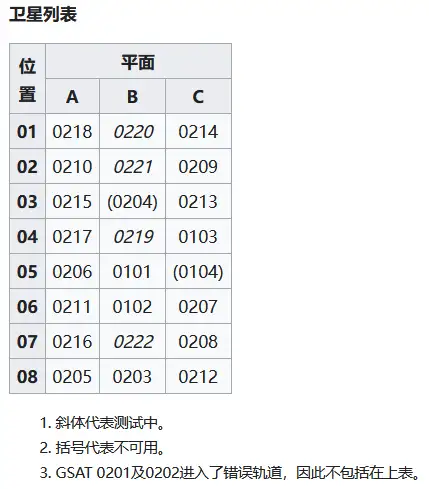
4.2 地面部分 | Ground segment
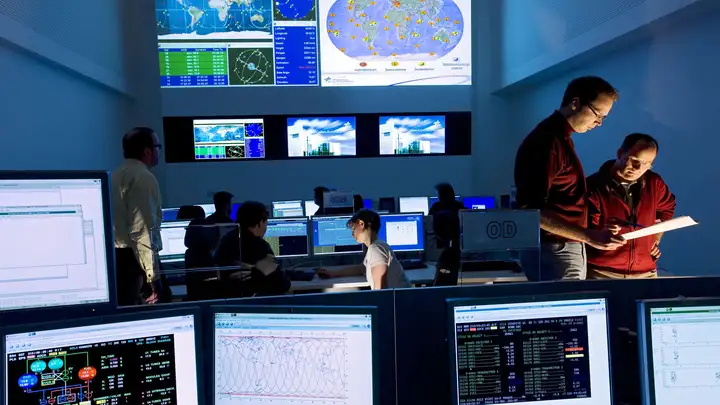
图片题注:Galileo Control Centre at the DLR Oberpfaffenhofen site (德国航空航天中心奥伯佩法芬霍芬站的伽利略控制中心)
图片来源:German Aerospace Center DLR

图片题注:Galileo In-Orbit Test (IOT) L-band (1,000 – 2,000 MHz) antenna at ESTRACK Redu Station (在ESTRACK Redu站进行的伽利略轨道测试(IOT)L频段(1,000 – 2,000 MHz)天线)
图片作者:ESA/C. Lezy
The system’s orbit and signal accuracy is controlled by a ground segment consisting of:
参考译文:该系统的轨道和信号精度由地面段控制,包括:
- Two ground control centres, located in Oberpfaffenhofen and Fucino for Satellite and Mission Control。
参考译文:卫星和任务控制的两个地面控制中心,分别位于奥伯佩法芬霍芬和富奇诺 - Six telemetry, tracking & control (TT&C) stations, located in Kiruna, Kourou, Nouméa, Sainte-Marie, Réunion, Redu and Papeete
参考译文:六个遥测、跟踪和控制(TT&C)站,分别位于基鲁纳、库鲁、努美阿、圣玛丽、留尼汪岛、雷杜和帕皮提。 - Ten mission data uplink stations (ULS), two per site, located in Svalbard, Kourou, Papeete, Sainte-Marie, Réunion and Nouméa
参考译文:十个任务数据上行站(ULS),每个站点两个,分别位于斯瓦尔巴、库、帕皮提、圣玛、留尼汪岛努美阿。 - Several worldwide distributed reference sensor stations (GSS), including one in the Kerguelen Islands
参考译文:全球分布的多个参考传感器站(GSS),包括一个位于凯尔盖朗群岛。 - A data dissemination network between all geographically distributed locations
参考译文:一个连接所有地理分布位置之间的数据传播网络。 - One service centre, located in Madrid, to help Galileo users.
参考译文:一个位于马德里的服务中心,为伽利略用户提供帮助。
4.3 信号 | Signals
The system transmits three signals: E1 (1575.42 MHz), E5 (1191.795 MHz) consisting of E5a (1176.45 MHz) and E5b (1207.14 MHz), and E6 (1278.75 MHz):[96]
参考译文:该系统发射三种信号:E1(1575.42 MHz),E5(1191.795 MHz),由E5a(1176.45 MHz)和E5b(1207.14 MHz)组成,以及E6(1278.75 MHz):[96]

4.4 服务 | Services
4.4.1 四种导航服务
伽利略系统”将提供以下四种导航服务:
- 开放服务:开放服务提供任何人自由使用,开放服务的信号将会广播1164-1214MHz 及 1563-1591MHz 两个频带上。同时接收两个频带的信号水平误差小于4米,垂直误差小于8米,如果只接收单一频带仍然有小于15米的水平误差及小于35米的垂直误差与GPS的C/A码相当。
- 商业服务
- 公共规范服务
- 生命安全服务
具体如下:
(1)开放系统 Open Service (OS)
This will be available without charge for use by anyone with appropriate mass-market equipment; simple timing, and positioning down to 1 m – for a double frequency receiver, best case.[97]
参考译文:这将免费提供给任何具备适当大众市场设备的人使用;简单的定时和定位精度可达到1米 – 对于双频接收器来说是最佳情况。[97]
High Accuracy Service (HAS; resulting from the re-scope of the former Galileo Commercial Service)
参考译文:高精度服务(HAS;源自前伽利略商业服务的重新界定)
Accuracy to 20 cm free of charge.[98]
参考译文:免费提供20厘米的精确度。[98]
(2)公共规范服务 Public Regulated Service (PRS; encrypted)
Designed to be more robust, with anti-jamming mechanisms and reliable problem detection. Limited to authorized governmental bodies.[99]
参考译文:设计更加稳健,具有防干扰机制和可靠的问题检测能力。仅限授权的政府机构使用。[99]
(3)生命安全服务(搜救服务)Search and Rescue Service (SAR)
The Galileo SAR Service is a Medium Earth Orbiting Search and Rescue (MEOSAR) service and part of the International Cospas-Sarsat Programme.[100]
参考译文:伽利略搜索与救援(SAR)服务是一项中地球轨道搜索与救援(MEOSAR)服务,是国际Cospas-Sarsat计划的一部分。[100]
4.4.2 季度服务绩效报告 | Quarterly Service Performance Reports
The European GNSS Service Centre provides public quarterly performance reports regarding the Open Service and Search and Rescue Service since 2017. Generally, the reported performance parameters measurements surpass the target values.[101] The Galileo April, May, June 2021 Quarterly Open Service Performance Report by the European GNSS Service Centre reported the UTC Time Dissemination Service Accuracy was ≤ 4.3 nanoseconds, computed by accumulating samples over the previous 12 months and exceeding the ≤ 30 ns target value. The Signal In Space Error (SISE) was also well within the ≤ 2 m (6 ft 7 in) target value for Single and (more accurate) Dual Frequency receivers.[102][103] The Galileo navigation message includes the differences between Galileo System Time (GST), UTC and GPS Time (GPST) (to promote interoperability).[104][105] The Galileo April, May, June 2021 Quarterly Search and Rescue Service Performance Report by the European GNSS Service Centre reported the various performance parameters measurements surpassed their target values. [106]
参考译文:自2017年以来,欧洲GNSS服务中心每季度提供公开的Open Service和Search and Rescue服务性能报告。一般来说,报告的性能参数测量值超过了目标值。[101] 欧洲GNSS服务中心发布的伽利略2021年4月、5月、6月季度开放服务性能报告显示,UTC时间传播服务的精度≤4.3纳秒,这是通过对过去12个月的样本进行累积计算得出的,超过了≤30纳秒的目标值。单频和(更准确的)双频接收机的信号在空间误差(SISE)也远低于≤2米(6英尺7英寸)的目标值。[102][103] 伽利略导航消息包括伽利略系统时间(GST)、协调世界时(UTC)和全球定位系统时间(GPST)之间的差异(以促进互操作性)。[104][105] 欧洲GNSS服务中心发布的伽利略2021年4月、5月、6月季度搜索和救援服务性能报告显示,各种性能参数测量值超过了其目标值。[106]
4.5 概念 | Concept

图片题注:Space Passive Hydrogen Maser used in Galileo satellites as a master clock for an timing system (伽利略卫星中使用的空间被动氢钟,用作计时系统的主时钟。)
图片来源:SkywalkerPL

Prototype Rb atomic clock for a Galileo satellite made in 2002(2002年制造的一枚伽利略卫星原型Rb原子钟。)
图片来源: Science Museum Collections
Each Galileo satellite has two master passive hydrogen maser atomic clocks and two secondary rubidium atomic clocks which are independent of one other.[107][108] As precise and stable space-qualified atomic clocks are critical components to any satellite-navigation system, the employed quadruple redundancy keeps Galileo functioning when onboard atomic clocks fail in space. The onboard passive hydrogen maser clocks’ precision is four times better than the onboard rubidium atomic clocks and estimated at 1 second per 3 million years (a timing error of a nanosecond or 1 billionth of a second (10−9 or 1⁄1,000,000,000 second) translates into a 30 cm positional error on Earth’s surface), and will provide an accurate timing signal to allow a receiver to calculate the time that it takes the signal to reach it.[109][110][65] The Galileo satellites are configured to run one hydrogen maser clock in primary mode and a rubidium clock as hot backup. Under normal conditions, the operating hydrogen maser clock produces the reference frequency from which the navigation signal is generated. Should the hydrogen maser encounter any problem, an instantaneous switchover to the rubidium clock would be performed. In case of a failure of the primary hydrogen maser the secondary hydrogen maser could be activated by the ground segment to take over within a period of days as part of the redundant system. A clock monitoring and control unit provides the interface between the four clocks and the navigation signal generator unit (NSU). It passes the signal from the active hydrogen master clock to the NSU and also ensures that the frequencies produced by the master clock and the active spare are in phase, so that the spare can take over instantly should the master clock fail. The NSU information is used to calculate the position of the receiver by trilaterating the difference in received signals from multiple satellites.
参考译文:每颗伽利略卫星都配备了两台主被动氢钟原子钟和两台独立的次级铷原子钟。精确稳定的航天级原子钟是任何卫星导航系统的关键组件,而采用四重冗余保证了当卫星上的原子钟故障时,伽利略系统仍能正常运行。卫星上的被动氢钟时钟的精度是次级铷原子钟的四倍,估计为每300万年1秒的时间误差(纳秒级别的时间误差相当于地球表面30厘米的位置误差),并提供精确的时间信号,使接收器能够计算信号到达的时间。伽利略卫星配置为主要运行一个氢钟,将铷钟作为热备份。在正常情况下,工作中的氢钟产生参考频率,从而生成导航信号。如果氢钟遇到任何问题,会立即切换到铷钟。如果主要氢钟发生故障,地面段可以激活次级氢钟,在几天内接管,作为冗余系统的一部分。时钟监控和控制单元提供了四个时钟与导航信号生成单元(NSU)之间的接口。它将信号从活动的氢主钟传递给NSU,并确保主钟和活动备份钟产生的频率相位一致,以便备份时钟可以立即接管,如果主钟失效。NSU的信息用于通过多个卫星接收到的信号差异进行三角测量计算接收器的位置。
The onboard passive hydrogen maser and rubidium clocks are very stable over a few hours. If they were left to run indefinitely, though, their timekeeping would drift, so they need to be synchronized regularly with a network of even more stable ground-based reference clocks. These include active hydrogen maser clocks and clocks based on the caesium frequency standard, which show a far better medium and long-term stability than rubidium or passive hydrogen maser clocks. These clocks on the ground are gathered together within the parallel functioning Precise Timing Facilities in the Fucino and Oberpfaffenhofen Galileo Control Centres. The ground based clocks also generate a worldwide time reference called Galileo System Time (GST), the standard for the Galileo system and are routinely compared to the local realisations of UTC, the UTC(k) of the European frequency and time laboratories.[111]
参考译文:卫星上的被动氢钟和铷钟在几小时内非常稳定。然而,如果让它们无限期地运行,它们的时间计量会漂移,因此需要定期与一组更稳定的地面参考时钟同步。这些地面参考时钟包括主动氢钟和基于铯频率标准的时钟,比铷钟或被动氢钟时钟在中长期稳定性上要好得多。这些地面时钟在富奇诺和奥伯帕芬霍芬的伽利略控制中心的精密定时设施中并行运行。地面时钟还生成一个名为伽利略系统时间(GST)的全球时间参考,这是伽利略系统的标准,并经常与欧洲频率和时间实验室的本地UTC实现(UTC(k))进行比较。
For more information of the concept of global satellite navigation systems, see GNSS and GNSS positioning calculation.
参考译文:有关全球卫星导航系统的概念的更多信息,请参阅“GNSS”和“GNSS定位计算”词条。
5. 欧洲GNSS服务中心 | European GNSS Service Centre
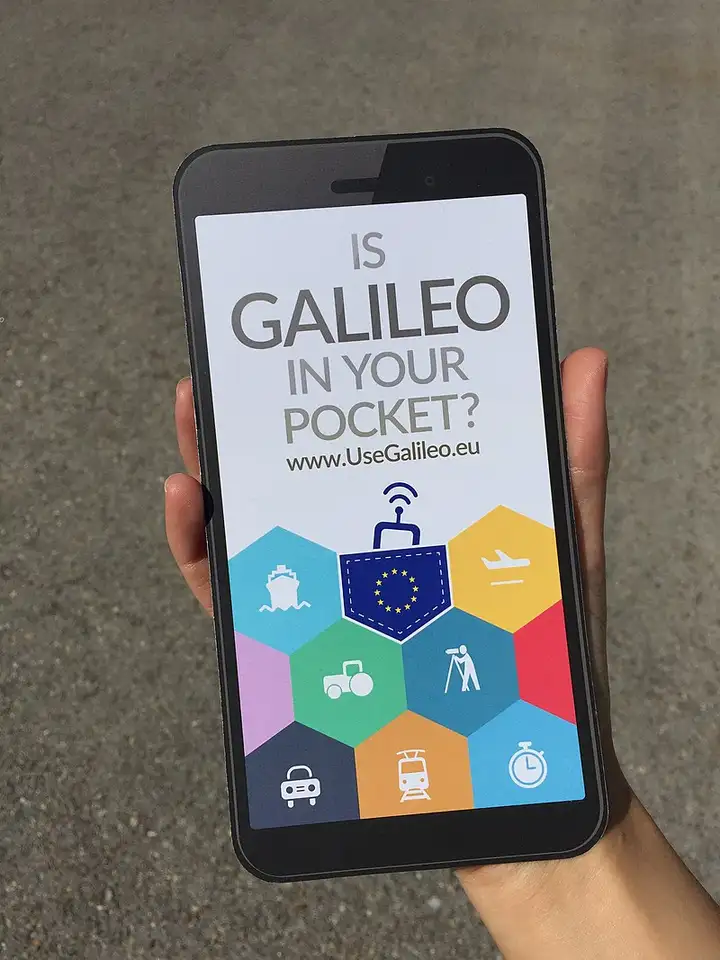
图片题注:The European GNSS Service Centre is the point of contact for Galileo users assistance.(欧洲GNSS服务中心是为伽利略用户提供协助的联络点。)
图片来源:GalileoSC
The European GNSS Service Centre (GSC),[112] located in Madrid, is an integral part of Galileo and provides the single interface between the Galileo system and Galileo users. GSC publishes Galileo official documentation, promotes Galileo current and future services worldwide, supports standardisation and distributes Galileo almanacs, ephemeris and metadata.
参考译文:欧洲GNSS服务中心(GSC)位于马德里,是伽利略系统与伽利略用户之间的唯一接口。GSC发布伽利略的官方文档,推广伽利略的当前和未来服务,并在全球范围内提供支持标准化工作,并分发伽利略的卫星星历、星历和元数据。
The GSC User Helpdesk[113] is the point of contact for Galileo user’s assistance. GSC answers queries and gathers incident notifications from users on Galileo. The helpdesk is continuously available for all worldwide Galileo users through the GSC web portal.
参考译文:GSC用户帮助台是为伽利略用户提供协助的联络点。GSC回答用户在伽利略方面的查询,并收集用户对伽利略的事件通知。用户可以通过GSC网站门户随时联系用户帮助台。
GSC provides updated Galileo constellation status and informs on planned and unplanned events through Notice Advisory to Galileo Users (NAGU).[114] GSC publishes Galileo reference documentation and general information on Galileo services and signals description and Galileo performance reports.
参考译文:欧洲GNSS服务中心通过对伽利略用户发布通知咨询(NAGU),提供更新的伽利略星座状态,并通报计划和非计划的事件。GSC发布伽利略的参考文档和有关伽利略服务、信号描述和性能报告的一般信息。
6. 搜救 | Search and rescue
Galileo provides a global search and rescue (SAR) function as part of the MEOSAR system. Like Russia‘s Glonass, the United States‘ Global Positioning System (GPS) satellites, and some Chinese BeiDou satellites, Galileo satellites are equipped with a transponder which relays 406 MHz distress frequency signals from emergency beacons by a Forward Link Service (FLS) to the Rescue coordination centre, which will then initiate a rescue operation.[115][116][117][118] After receipt of an emergency beacon signal, the Galileo SAR system provides a signal, the Return Link Message (RLM), to the emergency beacon, informing the person(s) in distress that the activated beacon has been detected and help is on the way. This return message feature is new in a satellite constellation and is considered a major upgrade compared to the existing Cospas-Sarsat system, which up to then did not provide feedback to the user.[119] Tests in February 2014 found that for Galileo’s search and rescue function, operating as part of the existing International Cospas-Sarsat Programme, 77% of simulated distress locations can be pinpointed within 2 kilometres (1.2 mi), and 95% within 5 kilometres (3.1 mi).[120] The Galileo Return Link Service (RLS) went live in January 2020 for all RLS capable emergency beacons.[121][122][123][124]
参考译文:伽利略作为MEOSAR系统的一部分,提供全球搜索和救援(SAR)功能。与俄罗斯的格洛纳斯、美国的全定位系统(GPS)卫星以及一些中国的北斗卫星类似,伽利略卫星配备了一个转发器,通过前向链路服务(FLS)将紧急信标发送的406 MHz求救频率信号传送到救援协调中心,然后启动救援行动。收到紧急信标信号后,伽利略SAR系统向紧急信标发送一个返回链路消息(RLM),通知遇险人员紧急信标已被探测到,并有救援即将到来。与现有的Cospas-Sarsat系统相比,这种返回消息功能是卫星星座中的一项新功能,并被认为是重大升级,因为之前的系统没有向用户提供反馈。2014年2月的测试发现,在作为现有国际Cospas-Sarsat计划的一部分运行的伽利略搜索和救援功能中,77%的模拟求救位置可以在2公里以内确定,95%的位置可以在5公里以内确定。伽利略返回链路服务(RLS)于2020年1月开始为所有具备RLS功能的紧急信标提供服务。
7. 卫星星座 | Constellation
Main article: List of Galileo satellites
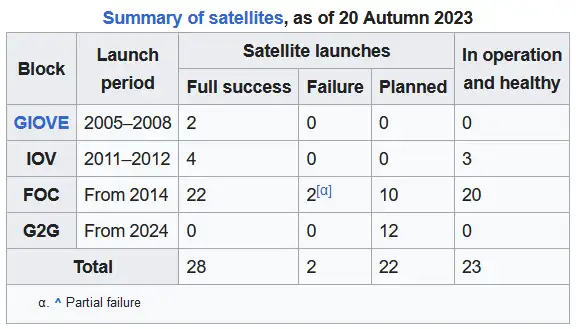
7.1 伽利略卫星测试平台:GIOVE | Galileo satellite test beds: GIOVE
Main article: GIOVE
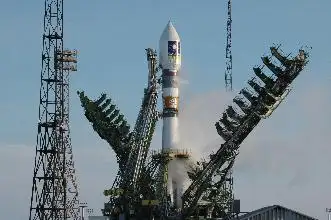
图片题注:GIOVE-A was successfully launched 28 December 2005. (GIOVE-A于2005年12月28日成功发射。)
图片来源:http://www.space.com/missionlaunches/051228_ap_galileo_launch.html
In 2004, the Galileo System Test Bed Version 1 (GSTB-V1) project validated the on-ground algorithms for Orbit Determination and Time Synchronisation (OD&TS). This project, led by ESA and European Satellite Navigation Industries, has provided industry with fundamental knowledge to develop the mission segment of the Galileo positioning system.[125]
参考译文:在2004年,伽利略系统试验床第一版(GSTB-V1)项目验证了地面算法用于轨道确定和时间同步(OD&TS)。该项目由欧洲航天局和欧洲卫星导航产业领导,为行业提供了开发伽利略定位系统任务段的基础知识。
- GIOVE-A is the first GIOVE (Galileo In-Orbit Validation Element) test satellite. It was built by Surrey Satellite Technology Ltd (SSTL), and successfully launched on 28 December 2005 by the European Space Agency and the Galileo Joint Undertaking (GJU). Operation of GIOVE-A ensured that Galileo meets the frequency-filing allocation and reservation requirements for the International Telecommunication Union (ITU), a process that was required to be complete by June 2006.
参考译文:GIOVE-A是第一颗GIOVE(伽利略轨道验证元素)测试卫星。它由Surrey Satellite Technology Ltd(SSTL)建造,并于2005年12月28日由欧洲航天局和伽利略联合计划(GJU)成功发射。GIOVE-A的运行确保了伽利略系统符合国际电信联盟(ITU)的频率分配和保留要求,这一过程要求在2006年6月之前完成。 - GIOVE-B, built by Astrium and Thales Alenia Space, has a more advanced payload than GIOVE-A. It was successfully launched on 27 April 2008 at 22:16 UTC aboard a Soyuz-FG/Fregat rocket provided by Starsem.
参考译文:GIOVE-B由Astrium和Thales Alenia Space建造,其有效载荷比GIOVE-A更先进。它于2008年4月27日22:16 UTC成功搭载在由Starsem提供的Soyuz-FG/Fregat火箭上发射。
A third satellite, GIOVE-A2, was originally planned to be built by SSTL for launch in the second half of 2008.[126] Construction of GIOVE-A2 was terminated due to the successful launch and in-orbit operation of GIOVE-B.
参考译文:原计划第三颗卫星GIOVE-A2由SSTL在2008年下半年发射。由于GIOVE-B的成功发射和轨道运行,GIOVE-A2的建造被终止。
The GIOVE Mission[127][128] segment operated by European Satellite Navigation Industries used the GIOVE-A/B satellites to provide experimental results based on real data to be used for risk mitigation for the IOV satellites that followed on from the testbeds. ESA organised the global network of ground stations to collect the measurements of GIOVE-A/B with the use of the GETR receivers for further systematic study. GETR receivers are supplied by Septentrio as well as the first Galileo navigation receivers to be used to test the functioning of the system at further stages of its deployment. Signal analysis of GIOVE-A/B data confirmed successful operation of all the Galileo signals with the tracking performance as expected.
参考译文:由欧洲卫星导航工业运营的GIOVE任务阶段利用GIOVE-A/B卫星提供基于真实数据的实验结果,用于随后的IOV卫星的风险缓解。ESA组织了全球地面站网络,利用GETR接收器收集GIOVE-A/B的测量数据,以进行进一步的系统研究。GETR接收器由Septentrio提供,同时也是第一批用于测试系统在部署的后续阶段功能的伽利略导航接收器。对GIOVE-A/B数据的信号分析确认了所有伽利略信号的成功运行,跟踪性能符合预期。
7.2 在轨验证(IOV)卫星 | In-Orbit Validation (IOV) satellites
These testbed satellites were followed by four IOV Galileo satellites that are much closer to the final Galileo satellite design. The search and rescue (SAR) feature is also installed.[129] The first two satellites were launched on 21 October 2011 from Centre Spatial Guyanais using a Soyuz launcher,[130] the other two on 12 October 2012.[131] This enables key validation tests, since earth-based receivers such as those in cars and phones need to “see” a minimum of four satellites in order to calculate their position in three dimensions.[131] Those 4 IOV Galileo satellites were constructed by Astrium GmbH and Thales Alenia Space. On 12 March 2013, a first fix was performed using those four IOV satellites.[132] Once this In-Orbit Validation (IOV) phase has been completed, the remaining satellites will be installed to reach the Full Operational Capability.
参考译文:这些测试平台卫星之后是四颗IOV伽利略卫星,它们更接近最终的伽利略卫星设计,并安装了搜救(SAR)功能。前两颗卫星于2011年10月21日通过联盟号火箭从法属圭亚那航天中心发射,另外两颗于2012年10月12日发射。这使得关键验证测试成为可能,因为基于地球的接收器(如汽车和手机中的接收器)需要“看到”至少四颗卫星才能计算出三维位置。这4颗IOV伽利略卫星由欧洲航天集团(Astrium GmbH)和Thales Alenia Space建造。2013年3月12日,使用这四颗IOV卫星进行了首次定位。完成这个IOV阶段后,剩余的卫星将被安装以达到全面运行能力。
7.3 全面运行能力(FOC)卫星 | Full Operational Capability (FOC) satellites
Main article: List of Galileo satellites(主条目:伽利略系统卫星列表)
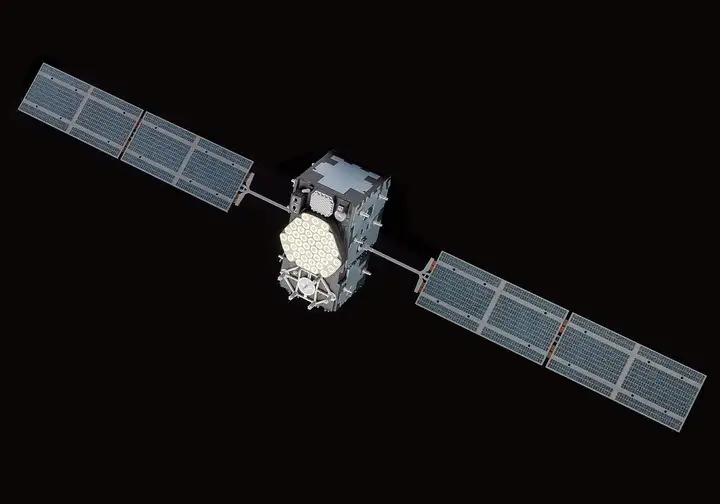
Model of a Galileo satellite(一个伽利略卫星的模型)
图片来源:This file comes from Science Museum Collections, a website operated by Science Museum Group, a non-departmental public body in the UK.
7.3.1 全面运行能力一批(FOC Batch 1)卫星 | FOC Batch 1
On 7 January 2010, it was announced that the contract to build the first 14 FOC satellites was awarded to OHB System and for the navigation payload to Surrey Satellite Technology Limited (SSTL). The first batch of Galileo First Generation satellites known as “Batch-1” consists of the Galileo-FOC FM1 to Galileo-FOC FM14 satellites. Fourteen satellites were built at a cost of €566 million (£510 million; US$811 million).[133][134] Arianespace will launch the satellites for a cost of €397 million (£358 million; US$569 million).[needs update] The European Commission also announced that the €85 million contract for system support covering industrial services required by ESA for integration and validation of the Galileo system had been awarded to Thales Alenia Space. Thales Alenia Space subcontract performances to Astrium GmbH and security to Thales Communications.
参考译文:在2010年1月7日,宣布将第一批14颗全面运行能力(FOC)卫星的建造合同授予了OHB System,并将导航载荷的合同授予了Surrey Satellite Technology Limited(SSTL)。这批第一代伽利略卫星被称为“Batch-1”,包括了Galileo-FOC FM1到Galileo-FOC FM14。共有14颗卫星建造完成,总成本为5.66亿欧元(5.1亿英镑;8.11亿美元)。Arianespace将以3.97亿欧元(3.58亿英镑;5.69亿美元)的费用进行卫星发射(需要更新)。欧洲委员会还宣布将8500万欧元的系统支持合同授予Thales Alenia Space,该合同涵盖了ESA所需的伽利略系统集成和验证的工业服务。Thales Alenia Space将与Astrium GmbH合作执行这些子承包任务,并将安全性任务交由Thales Communications负责。
7.3.2 全面运行能力二批(FOC Batch 2)| FOC Batch 2
In February 2012, an additional order of 8 FOC satellites was awarded to OHB Systems for €250 million (US$327 million), after outbidding EADS Astrium tender offer. The second batch of Galileo First Generation satellites known as “Batch-2” consists of the Galileo-FOC FM15 to Galileo-FOC FM22 satellites. Thus bringing the total to 22 FOC satellites.[135] The satellites were built by OHB, with the contribution of Surrey Satellite Technology (SSTL).[136]
参考译文:2012年2月,额外订购了8颗全面运行能力(FOC)卫星,合同金额为2.5亿欧元(3.27亿美元),该合同授予了OHB Systems,它在竞标中击败了EADS Astrium。这批第二批伽利略卫星被称为“Batch-2”,包括了Galileo-FOC FM15到Galileo-FOC FM22。这使得FOC卫星的总数增至22颗。这些卫星由OHB建造,其中也有Surrey Satellite Technology Limited(SSTL)的贡献。
7.3.3 全面运行能力三批(FOC Batch 3)| FOC Batch 3
In June and October 2017, two additional orders for 8 and 4 FOC satellites were awarded to OHB Systems for €324 million and €157.75 million. This third and final batch of Galileo First Generation satellites known as “Batch-3” consists of the Galileo-FOC FM23 to Galileo-FOC FM34 satellites. The satellites are being built by OHB in Bremen, Germany, with the contribution of Surrey Satellite Technology (SSTL) in Guildford, United Kingdom.[137][138][139][140][141] When completed Batch-3 brings the total to 34 FOC satellites.
参考译文:在2017年6月和10月,又额外订购了8颗和4颗全面运行能力(FOC)卫星,合同金额分别为3.24亿欧元1.5775亿欧元。这是第三批也是最后一批伽利略第一代卫星,被称为“Batch-3”,包括了Galileo-FOC FM23到Galileo-FOC FM34。这些卫星由OHB在德国不来梅建造,同时也得到了英国吉尔福德的Surrey Satellite Technology Limited(SSTL)的贡献。完成Batch-3后,FOC卫星的总数将达到34颗。
7.3.4 FOC发射 | FOC launches
On 7 May 2014, the first two FOC satellites landed in Guyana for their joint launch planned in summer[142] Originally planned for launch during 2013, problems tooling and establishing the production line for assembly led to a delay of a year in serial production of Galileo satellites. These two satellites (Galileo satellites GSAT-201 and GSAT-202) were launched on 22 August 2014.[143] The names of these satellites are Doresa and Milena named after European children who had previously won a drawing contest.[144] On 23 August 2014, launch service provider Arianespace announced that the flight VS09 experienced an anomaly and the satellites were injected into an incorrect orbit.[145] They ended up in elliptical orbits and thus could not be used for navigation. However, it was later possible to use them to perform a physics experiment, so they were not a complete loss.[146]
参考译文:2014年5月7日,前两颗FOC卫星抵达圭亚那,计划在夏季进行联合发射。最初计划于2013年发射,但由于制造工具和装配线的建立问题,导致了一年的延迟。这两颗卫星(伽利略卫星GSAT-201和GSAT-202)于2014年8月22日发射。这两颗卫星的名字分别是多蕾莎(Doresa)和米莉娜(Milena),以之前赢得绘画比赛的欧洲儿童命名。2014年8月23日,发射服务提供商Arianespace宣布,飞行任务VS09出现异常,卫星被注入了错误的轨道。它们最终进入了椭圆轨道,因此无法用于导航。然而,后来它们被用于进行物理实验,因此并不完全损失。
Satellites GSAT-203 (Adam) and GSAT-204 (Anastasia) were launched successfully on 27 March 2015 from Guiana Space Centre using a Soyuz four stage launcher.[147][148]
参考译文:GSAT-203(亚当)和GSAT-204(安娜斯塔西娅)卫星于2015年3月27日成功从圭亚那航天中心使用联盟Soyuz四级运载火箭发射。
Satellites GSAT-205 (Alba) and GSAT-206 (Oriana) were launched successfully on 11 September 2015 from Guiana Space Centre using a Soyuz four stage launcher.[149]
参考译文:GSAT-205(阿尔巴)和GSAT-206(奥里亚娜)卫星于2015年9月11日成功从圭亚那航天中心使用联盟Soyuz四级运载火箭发射。
Satellites GSAT-208 (Liene) and GSAT-209 (Andriana) were successfully launched from Kourou, French Guiana, using the Soyuz four stage launcher on 17 December 2015.[150][151][152][153]
参考译文:GSAT-208(琳娜)和GSAT-209(安德里亚娜)卫星于2015年12月17日成功从法属圭亚那的库鲁发射场使用联盟Soyuz四级运载火箭发射。
Satellites GSAT-210 (Daniele) and GSAT-211 (Alizée) were launched on 24 May 2016.[154][155]
参考译文:GSAT-210(达尼埃尔)和GSAT-211(阿丽泽)卫星于2016年5月24日发射成功。
Starting in November 2016, deployment of the last twelve satellites will use a modified Ariane 5 launcher,[needs update] named Ariane 5 ES, capable of placing four Galileo satellites into orbit per launch.[156]
参考译文:自2016年11月开始,最后12颗卫星的部署将使用改进后的阿里亚娜5号运载火箭(需要更新),名为阿里亚娜5 ES,每次发射能够将四颗伽利略卫星送入轨道。
Satellites GSAT-207 (Antonianna), GSAT-212 (Lisa), GSAT-213 (Kimberley), GSAT-214 (Tijmen) were successfully launched from Kourou, French Guiana, on 17 November 2016 on an Ariane 5 ES.[157][158]
参考译文:GSAT-207(安东尼安娜)、GSAT-212(莉萨)、GSAT-213(金伯利)和GSAT-214(提曼)卫星于2016年11月17日成功从法属圭亚那的库鲁发射场使用阿里亚娜5 ES运载火箭发射。
On 15 December 2016, Galileo started offering Initial Operational Capability (IOC). The services currently offered are Open Service, Public Regulated Service and Search and Rescue Service.[1]
参考译文:2016年12月15日,伽利略开始提供初步运行能力(IOC)。目前提供的服务包括开放服务、公共受控服务和搜索与救援服务。
The first Batch-2 satellites GSAT-215 (Nicole), GSAT-216 (Zofia), GSAT-217 (Alexandre), GSAT-218 (Irina) were successfully launched from Kourou, French Guiana, on 12 December 2017 on an Ariane 5 ES.[159][160]
参考译文:第一批Batch-2卫星GSAT-215(妮可)、GSAT-216(苏菲娅)、GSAT-217(亚历山大)和GSAT-218(伊琳娜)于2017年12月12日成功从法属圭亚那的库鲁发射场使用阿里亚娜5 ES运载火箭发射。
Satellites GSAT-219 (Tara), GSAT-220 (Samuel), GSAT-221 (Anna), GSAT-222 (Ellen) were successfully launched from Kourou, French Guiana, on 25 July 2018 on an Ariane 5 ES.[161]
参考译文:GSAT-219(塔拉)、GSAT-220(塞缪尔)、GSAT-221(安娜)和GSAT-222(埃伦)卫星于2018年7月25日成功从法属圭亚那的库鲁发射场使用阿里亚娜5 ES运载火箭发射。
The first Batch-3 satellites GSAT-223 (Nikolina) and GSAT-224 (Shriya) were successfully launched from Kourou, French Guiana, on 5 December 2021 on a Soyuz four stage launcher.[162][163]
参考译文:第一批Batch-3卫星GSAT-223(妮科丽娜)和GSAT-224(施丽娅)于2021年12月5日成功从法属圭亚那的库鲁发射场使用联盟号四级运载火箭发射。
Shriya successfully joined the constellation on 29 August 2022.[164]
参考译文:施丽娅于2022年8月29日成功加入星座。
7.4 第二代(G2G)卫星 | Second generation (G2G) satellites
As of 2014, ESA and its industry partners have begun studies on Galileo Second Generation (G2G) satellites, which will be presented to the EC for the late 2020s launch period.[165] One idea is to employ electric propulsion, which would eliminate the need for an upper stage during launch and allow satellites from a single batch to be inserted into more than one orbital plane. The new generation satellites are expected to be available by 2025.[166] and serve to augment the existing network. On 20 January 2021, the European Commission announced that it had awarded a €1.47 billion contract to Thales Alenia Space (TAS) and Airbus Defence and Space for 6 spacecraft by each manufacturer.[27] The signing of the contracts to Thales Alenia Space and Airbus Defence and Space, scheduled on 29 January 2021, was suspended by the European Court of Justice following a protest filed by OHB SE, the losing bidder. The OHB protest at the ECJ’s General Court is based on “allegations of theft of trade secrets”, and seeks both a suspension of the contract signatures and the cancellation of the contract award. In May 2021 ESA reported it signed the contracts to design and build the first batch of Galileo Second Generation (G2G) satellites with Thales Alenia Space and Airbus Defence and Space. The 12 G2G satellites will feature electric propulsion, enhanced navigation signals and capabilities, inter-satellite links and reconfigurability in space.[167][168] [169][28]
参考译文:截至2014年,欧洲航天局(ESA)及其工业合作伙伴已开始对伽利略第二代(G2G)卫星进行研究,并计划在2020年代末向欧盟(EC)提出计划。其中一个想法是采用电推进技术,这将消除发射过程中需要上层级的需求,并使同一批卫星可以插入多个轨道平面。预计新一代卫星将于2025年可用,并用于增强现有网络。2021年1月20日,欧洲委员会宣布已向Thales Alenia Space(TAS)和Airbus Defence and Space分别授予了14.7亿欧元的合同,每家制造商将提供6颗卫星。原定于2021年1月29日签署合同的Thales Alenia Space和Airbus Defence and Space的签约被欧洲法院暂停,原因是被败诉的OHB SE提出了抗议。OHB在欧洲法院的普通法院提起的抗议基于“窃取商业机密”的指控,并要求暂停签署合同和取消合同授予。2021年5月,欧洲航天局报告称已与Thales Alenia Space和Airbus Defence and Space签署了设计和建造伽利略第二代(G2G)卫星第一批的合同。这批12颗G2G卫星将具有电推进、增强导航信号和能力、卫星间链路和空间可重配置性。
8. 应用和影响 | Applications and impact
8.1 使用伽利略的科学项目 | Science projects using Galileo
In July 2006, an international consortium of universities and research institutions embarked on a study of potential scientific applications of the Galileo constellation. This project, named GEO6,[170] is a broad study oriented to the general scientific community, aiming to define and implement new applications of Galileo.
参考译文:在2006年7月,一个由国际大学和研究机构组成的联盟开始了对伽利略星座潜在科学应用的研究。这个项目名为GEO6,是一个面向广泛科学界的广泛研究,旨在定义和实施伽利略的新应用。
Among the various GNSS users identified by the Galileo Joint Undertaking,[171] the GEO6,[170] project addresses the Scientific User Community (UC). The GEO6[170] project aims at fostering possible novel applications within the scientific UC of GNSS signals, and particularly of Galileo.
参考译文:在伽利略联合企业确定的各种全球导航卫星系统(GNSS)用户中,GEO6项目针对科学用户社区(UC)进行研究。GEO6项目旨在促进全球导航卫星系统信号在科学用户社区内的可能的新应用,尤其是伽利略的应用。
The AGILE[172] project is an EU-funded project devoted to the study of the technical and commercial aspects of location-based services (LBS). It includes technical analysis of the benefits brought by Galileo (and EGNOS) and studies the hybridisation of Galileo with other positioning technologies (network-based, WLAN, etc.). Within these projects, some pilot prototypes were implemented and demonstrated.
参考译文:AGILE项目是一个由欧盟资助的项目,致力于研究基于位置的服务(LBS)的技术和商业方面。它包括对伽利略(和EGNOS)带来的好处的技术分析,并研究了伽利略与其他定位技术(基于网络、WLAN等)的混合应用。在这些项目中,一些试验原型被实施和演示出来。
On the basis of the potential number of users, potential revenues for Galileo Operating Company or Concessionaire (GOC), international relevance, and level of innovation, a set of Priority Applications (PA) will be selected by the consortium and developed within the time-frame of the same project.
参考译文:根据潜在用户数量、潜在收益、国际影响力和创新水平,由联盟选择一组优先应用(PA),并在同一项目期限内进行开发。这些优先应用将为伽利略运营公司或特许权持有人(GOC)选择并开发。
These applications will help to increase and optimise the use of the EGNOS services and the opportunities offered by the Galileo Signal Test-Bed (GSTB-V2) and the Galileo (IOV) phase.
参考译文:这些应用将有助于增加和优化对EGNOS服务的使用,以及利用伽利略信号测试床(GSTB-V2)和伽利略(IOV)阶段提供的机会。
All Galileo satellites are equipped with laser retroreflector arrays which allow them to be tracked by the stations of the International Laser Ranging Service.[173] Satellite laser ranging to Galileo satellites are used for the validation of satellite orbits,[174] determination of Earth rotation parameters[175] and for the combined solutions incorporating laser and microwave observations.
参考译文:所有伽利略卫星都配备了激光反射器阵列,使它们可以被国际激光测距服务的站点追踪。通过对伽利略卫星进行激光测距,可以用于验证卫星轨道、确定地球旋转参数,以及结合激光和微波观测进行综合解决方案。
8.2 接收器 | Receivers

Samsung Galaxy S8+ smartphones receiving Galileo and other GNSS signals (三星Galaxy S8+智能手机接收伽利略和其他GNSS信号。)
图片来源:ESA–G. Porter
All major GNSS receiver chips support Galileo and hundreds of end-user devices are compatible with Galileo.[5] The first, dual-frequency-GNSS-capable Android devices, which track more than one radio signal from each satellite, E1 and E5a frequencies for Galileo, were the Huawei Mate 20 line, Xiaomi Mi 8, Xiaomi Mi 9 and Xiaomi Mi MIX 3.[176][177][178] As of July 2019, there were more than 140 Galileo-enabled smartphones on the market of which 9 were dual-frequency enabled.[179][non-primary source needed] An extensive list of enabled devices, for various uses, on land, sea and in air is frequently updated at the EU website.[180] On 24 December 2018, the European Commission passed a mandate for all new smartphones to implement Galileo for E112 support.[181]
参考译文:所有要的GNSS接收芯片都支持伽利略,数百种终端设备与伽利略兼容。第一批支持双频GNSS的Android设备,可以同时跟踪每颗卫星的多个射频信号,其中包括伽利略的E1和E5a频率,是华为Mate 20系列、小米Mi 8、小米Mi 9和小米MIX 3等设备。截至2019年7月,市场上有140多款支持伽利略的智能手机,其中9款支持双频功能。欧盟网站定期更新了用于陆地、海洋和空中等各种用途的支持设备的详细列表。2018年12月24日,欧洲委员会通过了一项决议,要求所有新型智能手机实施伽利略以支持E112。
Effective from 1st April 2018, all new vehicles sold in Europe must support eCall, an automatic emergency response system that dials 112 and transmits Galileo location data in the event of an accident.[182]
参考译文:从2018年4月1日起,所有在欧洲销售的新车必须持eCall,这一个自动紧急响应系统,在事故发生时拨打112并传输伽利略位置数据。
Until late 2018, Galileo was not authorized for use in the United States and, as a consequence, only variably worked on devices that could receive Galileo signals, within United States territory.[183] The Federal Communications Commission‘s (FCC) position on the matter was (and remains) that non-GPS radio navigation satellite systems (RNSS) receivers must be granted a licence to receive said signals.[184] A waiver of this requirement for Galileo was requested by the EU and submitted in 2015, and on 6 January 2017, public comment on the matter was requested.[185] On 15 November 2018, the FCC granted the requested waiver, explicitly allowing non-federal consumer devices to access Galileo E1 and E5 frequencies.[186][187] However, most devices, including smartphones still require operating system updates or similar updates to allow the use of Galileo signals within the United States (most smartphones since the Apple iPhone 6S and Samsung Galaxy S7 have the hardware capability, and simply require a software modification).[188]
参考译文:直到2018年底,伽利略在美国并未获得使用授权,因此只有在美国境内能接收到伽利略信号的设备才能部分使用它。美国联邦通信委员会(FCC)对此事的立场是(并仍然是)非GPS无线导航卫星系统(RNSS)接收器必须获得接收该信号的许可。欧盟曾于2015年请求豁免伽利略的这一要求,并在2017年1月6日公开征求了对此事的意见。2018年11月15日,FCC批准了所请求的豁免,并明确允许非联邦消费者设备访问伽利略的E1和E5频率。然而,大多数设备,包括智能手机,在美国境内使用伽利略信号仍然需要操作系统更新或类似的软件更新(自苹果iPhone 6S和三星Galaxy S7以来的大多数智能手机都具备硬件功能,只需进行软件修改即可)
8.3 纪念硬币 | Coins
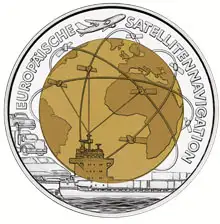
Austrian €25 European Satellite Navigation commemorative coin, back (奥地利25欧元欧洲卫星导航纪念币,背面。)
图片来源:http://austrian-mint.at
The European Satellite Navigation project was selected as the main motif of a very high-value collectors’ coin: the Austrian European Satellite Navigation commemorative coin, minted on 1 March 2006. The coin has a silver ring and gold-brown niobium “pill”. In the reverse, the niobium portion depicts navigation satellites orbiting the Earth. The ring shows different modes of transport, for which satellite navigation was developed: an aircraft, a car, a lorry, a train and a container ship.
参考译文:欧洲卫星导航项目被选为一枚非常高价值的收藏纪念币的主题:奥地利欧洲卫星导航纪念币,于2006年3月1日铸造。该币有一个银环和一个金褐色的铌“柱”。在背面,铌部分描绘了绕地球轨道运行的导航卫星。银环展示了卫星导航所开发的不同运输方式:飞机、汽车、卡车、火车和集装箱船。
9. 参见(相关词条)See also
9.1 与之竞争的系统 | Competing systems
Main article: Satellite navigation(主条目:卫星导航)
- BeiDou (BDS) – global system deployed and operated by China. 北斗卫星导航系统(BDS)
- GLONASS – global system deployed and operated by Russia. 格洛纳斯系统(GLONASS)
- GPS – global system deployed and operated by United States. 全球定位系统(GPS)
- Michibiki (QZSS) – regional navigation system deployed and operated by Japan, receivable in the Asia-Oceania regions, with a focus on Japan. 准天顶卫星系统(QZSS)
- NavIC – regional system deployed and operated by India, receivable in the South Asia and Western Asia regions. 印度区域导航卫星系统(IRNSS)
- 多普勒卫星涮轨和无线电定位组合系统(DORIS/朵丽丝系统)
- 辅助全球卫星定位系统(AGPS)
- 北斗卫星导航试验系统
- GPS误差分析(Error analysis for the GPS)
- 多时段定位法
9.2 其他 | Other
- List of Galileo satellites(伽利略系统卫星列表)
- Commercialization of space(太空商业化)
- European Geostationary Navigation Overlay Service(欧洲对地静止导航覆盖服务)
- Multiplexed binary offset carrier modulation – the modulation type chosen for Galileo Open Service signals and modernized GPS signals(复用二进制偏移载波调制——为伽利略开放服务信号和现代化 GPS 信号选择的调制类型)
- International Terrestrial Reference System and Frame – the coordinate system used by Galileo(国际地球参考系和坐标系 – 伽利略使用的坐标系)
10. 文献
11.1 英文词条
11.1.1 引用列表 Reference
- · “Galileo begins serving the globe”. European Space Agency. Retrieved 15 December 2016.
- · “Constellation Information | European GNSS Service Centre”. www.gsc-europa.eu. Archived from the original on 31 December 2019. Retrieved 28 February 2020.
- · “NAGUs (Notice Advisory to Galileo Users) | European GNSS Service Centre”. www.gsc-europa.eu. Retrieved 28 February 2020.
- · “Brexit is breaking up Europe’s €10 billion plan to launch a new constellation of satellites”. Quartz. Retrieved 28 April 2018.
- · “Galileo Initial Services”. gsa.europa.eu. 9 December 2016. Retrieved 25 September 2020.
- · “On a Civil Global Navigation Satellite System (GNSS) between the European Community and its Member States and Ukraine” (PDF). Archived (PDF) from the original on 8 February 2015. Retrieved 12 January 2015.
- · “The opening ceremony of GSA Agency’s headquarters was attended by VIPs in space activities and satellite navigation”. czechspaceportal.cz (in Czech). 10 September 2012. Archived from the original on 2 April 2018. Retrieved 2 April 2018.
- · “Galileo navigational system enters testing stage”. Deutsche Welle. Retrieved 13 October 2012.
- · “Why Europe needs Galileo”. ESA. 12 April 2010. Retrieved 21 June 2014.
- · “Directions 2018: Galileo ascendant”. GPS World. 8 December 2017. Retrieved 8 May 2021.
- · “EU Space Policy: Galileo”. European Commission Defense Industry and Space. European Commission. Archived from the original on 2 January 2022.
- · “New Satellite Launch Extends Galileo’s Global Reach”. European Space Agency. 25 July 2018. Retrieved 23 September 2018.
- · “Galileo launch brings navigation network close to completion”. 13 December 2017.
- · “Galileo Future and Evolutions”. European Space Agency. Retrieved 24 August 2021.
- · “Galileo begins serving the globe”. INTERNATIONALES VERKEHRSWESEN (in German). 23 December 2016.
- · “Soyuz launch from Kourou postponed until 2021, 2 others to proceed”. Space Daily. 19 May 2020.
- · “Constellation Information | European GNSS Service Centre”. www.gsc-europa.eu. Retrieved 17 October 2019.
- · “Galileo Elliptical Auxiliary Satellites Removed from Service”. Inside GNSS. 23 February 2021. Retrieved 17 December 2021.
- · Hadas, Tomasz; Kazmierski, Kamil; Sośnica, Krzysztof (7 August 2019). “Performance of Galileo-only dual-frequency absolute positioning using the fully serviceable Galileo constellation”. GPS Solutions. 23 (4). doi:10.1007/s10291-019-0900-9.
- · “After 13 years, Galileo satellite navigation complete at last”. De Ingenieur (in Dutch).
- · Kazmierski, Kamil; Zajdel, Radoslaw; Sośnica, Krzysztof (2020). “Evolution of orbit and clock quality for real-time multi-GNSS solutions”. GPS Solutions. 24 (111). doi:10.1007/s10291-020-01026-6.
- · Bury, Grzegorz; Sośnica, Krzysztof; Zajdel, Radosław; Strugarek, Dariusz (2020). “Toward the 1-cm Galileo orbits: challenges in modeling of perturbing forces”. Journal of Geodesy. 94 (16): 16. Bibcode:2020JGeod..94…16B. doi:10.1007/s00190-020-01342-2.
- · Modola, Pino (23 November 2007). “Italy and Germany make step towards Galileo satellite navigation programme financing resolution”. flightglobal.com.
- · Johnson, Christine (June 2004). “U.S., EU to Sign Landmark GPS-Galileo Agreement”. Wayback Machine. Archived from the original on 21 January 2012.
- · “Italy and Germany reach agreement on Galileo contributions”. cordis.europa.eu. 1 April 2003.
- · “Satellites Galileo : Thales se taille la part du lion”. 20 July 2023.
- · Hill, Jeffrey (20 January 2021). “Thales Alenia Space, Airbus Win Second-Generation Galileo Satellite Contract”. Satellite Today. Archived from the original on 26 January 2021. Retrieved 27 January 2021.
- · “Thales Alenia Space will play a major role on-board Galileo 2nd Generation and will boost performances and cybersecurity for the constellation”. Thaes Alenia Space. 3 March 2021. Retrieved 13 December 2021.
- · Van Der Jagt, Culver “Galileo: The Declaration of European Independence” a presentation at the Royal Institute of Navigation 7 November 2001
- · Sample, Ian (8 December 2003). “Europe and US clash on satellite system”. The Guardian. Retrieved 29 October 2011.
- · Johnson, Chalmers (2008). Nemesis: The Last Days of the American Republic. Holt. p. 235. ISBN 978-0-8050-8728-4.
- · Fernandez-Hernandez, I.; Vecchione, G.; Díaz-Pulido, F.; Jeannot, M.; Valentaite, G.; Blasi, R.; Reyes, J.; Simón, J. (October 2018). Galileo High Accuracy: A Programme and Policy Perspective. 69th International Astronautical Congress. Bremen, Germany – via ResearchGate.
- · Taverna, Michael A. (1 February 2011). “Completing Galileo To Cost $2.5 Billion”. Aviation Weekly.[permanent dead link]
- ·
This article incorporates text from this source, which is in the public domain: “GPS and Selective Availability Q&A” (PDF). NOAA. Archived from the original (PDF) on 21 September 2005. Retrieved 28 May 2010.
- · “EU, U.S. split over Galileo M-code overlay”. GPS World. FindArticles.com. December 2002. Archived from the original on 28 June 2009. Retrieved 9 December 2008.
- · “US Could Shoot Down EU Satellites if Used by Foes in Wartime”. AFP. 24 October 2004. Retrieved 9 September 2008.
- · Giegerich, Bastian (2005). “Satellite States – Transatlantic Conflict and the Galileo System”. Paper presented at the annual meeting of the International Studies Association, Hilton Hawaiian Village, Honolulu, Hawaii, Mar 05, 2005. Unpublished Manuscript.[permanent dead link]
- ·
This article incorporates text from this source, which is in the public domain: “Satellite Navigation – GPS – Policy – Selective Availability”. faa.gov. 13 November 2014.
- · “DoD Permanently Discontinues Procurement of Global Positioning System Selective Availability”. DefenseLink. 18 September 2007. Archived from the original on 18 February 2008. Retrieved 17 December 2007.
- ·
This article incorporates text from this source, which is in the public domain: “GPS.gov: Selective Availability”. www.gps.gov. Retrieved 4 February 2018.
- · “‘Unanimous backing’ for Galileo”. BBC. 30 November 2007. Retrieved 19 April 2010.
- · “Commission awards major contracts to make Galileo operational early 2014”. 7 January 2010. Retrieved 19 April 2010.
- · Gibbons, Glen (26 March 2009). “European Court of Auditors Lambastes Galileo Satellite Navigation Program”. Wayback Machine. Archived from the original on 12 January 2014.
- · “EU: Galileo project in deep ‘crisis'”. Wayback Machine. 8 May 2007. Archived from the original on 11 May 2007.
- · “MSN | Outlook, Office, Skype, Bing, Breaking News, and Latest Videos”. www.msn.com.
- · “EU agrees 2008 budget to include Galileo financing”. Wayback Machine. 26 November 2007. Archived from the original on 25 December 2007.
- · “Galileo ‘compromise’ is emerging”. BBC News. 23 November 2007. Retrieved 3 May 2010.
- · “Galileo legal process ticks over”. BBC News. 7 April 2008. Retrieved 3 May 2010.
- · “European Court of Auditors – Special Report on the management of the Galileo programme’s development and validation phase” (PDF). Archived from the original (PDF) on 28 November 2009.
- · “EC Cuts Initial Galileo Order”. Aviation Week Network. 26 October 2009. Retrieved 14 July 2021.
- · “The EU’s Galileo satellite project could cost UK taxpayers £2.6 billion more than originally planned” (Press release). openeurope.org.uk. 17 October 2010. Archived from the original on 19 July 2011. Retrieved 24 November 2010.
- · “Inauguration of site of Galileo station at Kourou”. European Space Agency (esa.int). 20 November 2009.
- · “Initial Galileo Validation Satellites Delayed”. SpaceNews. 10 March 2010. Retrieved 29 October 2011.
- · “EU Expects Galileo Project Costs to Explode”. Spiegel. 2011.
- · “Galileo’s navigation control hub opens in Fucino”. ESA. 20 December 2010. Retrieved 20 December 2010.
- · Keating, Dave (13 December 2010). “Prague To Host EU Satellite Navigation Agency”. RadioFreeEurope/RadioLiberty. Retrieved 14 July 2021.
- · “OHB-SYSTEM CEO CALLS GALILEO A WASTE OF GERMAN TAX PAYER MONEY”. Wayback Machine. 22 October 2009. Archived from the original on 14 January 2011.
- · “Europe’s Galileo sat-nav in big cash boost”. BBC News. 22 June 2011.
- · “Arianespace scores a double success with its historic first Soyuz launch from the Spaceport”. Wayback Machine. 21 October 2011. Archived from the original on 22 October 2011.
- · “Keeping up the Arianespace launcher family pace: Soyuz orbits two Galileo satellites”. Wayback Machine. 12 October 2012. Archived from the original on 16 October 2012.
- · Sośnica, Krzysztof; Prange, Lars; Kaźmierski, Kamil; Bury, Grzegorz; Drożdżewski, Mateusz; Zajdel, Radosław; Hadas, Tomasz (24 July 2017). “Validation of Galileo orbits using SLR with a focus on satellites launched into incorrect orbital planes”. Journal of Geodesy. 92 (2): 131–148. doi:10.1007/s00190-017-1050-x.
- · “What is Galileo?”. European Space Agency (esa.int).
- · “Galileo clock anomalies under investigation”. European Space Agency (ESA). 19 January 2017. Retrieved 19 January 2017.
- · “Atomic clocks ‘failed’ onboard Galileo navigation satellites”. Agence France-Presse AFP. 18 January 2017. Archived from the original on 18 January 2017. Retrieved 19 January 2017.
- · “Galileo satellites experiencing multiple clock failures”. British Broadcasting Corporation (BBC). 17 January 2017. Retrieved 18 January 2017.
- · “Rash of Galileo clock failures cast doubt on timing of upcoming launches”. spacenews.com. 19 January 2017. Retrieved 29 January 2017.
- · “ISRO readies replacement satellite after clock failure”. defencenews.in. Archived from the original on 22 September 2017. Retrieved 22 September 2017.
- · “ISRO readies replacement satellite after clock failure”. The Indian Express. 29 August 2017. Retrieved 22 September 2017.
- · D.S., Madhumathi. “Atomic clocks on indigenous navigation satellite develop snag”. The Hindu. Retrieved 6 March 2017.
- · Mukunth, Vasudevan. “3 Atomic Clocks Fail Onboard India’s ‘Regional GPS’ Constellation”. thewire.in. Retrieved 6 March 2017.
- · “Europe’s Galileo Satnav Identifies Problems Behind Failing Clocks”. NDTV Gadgets360.com. Retrieved 22 September 2017.
- · “Europe’s Galileo satnav identifies problems behind failing clocks”. phys.org. 21 July 2017. Retrieved 15 September 2017.
- · “Europe’s Galileo satnav identifies problems behind failing clocks”. AFP-The Express Tribune. 4 July 2017. Retrieved 15 September 2017.
- · “Galileo down over weekend”. GPS World. 14 July 2019. Retrieved 14 July 2019.
- · Amos, Jonathan (15 July 2019). “Galileo sat-nav system experiences service outage”. BBC News.
- · “Constellation Information | European GNSS Service Centre”. 14 July 2019. Archived from the original on 14 July 2019. Retrieved 14 July 2019.
- · “Galileo Initial Services have now been restored | European GNSS Service Centre”. www.gsc-europa.eu.
- · “Galileo nominal service restored”. European GNSS Service Centre. 14 December 2020. Retrieved 13 January 2021.
- · “Further information on the event of 14th December”. European GNSS Service Centre. 15 December 2020. Retrieved 13 January 2021.
- · “China joins EU’s satellite network”. BBC News. 19 September 2003.
- · “Israel joins Galileo The Israel Entity MATIMOP, on the way to becoming a Member of the Galileo Joint Undertaking” (PDF). eu-del.org.il. 18 May 2005. Archived from the original (PDF) on 9 July 2007. Retrieved 14 July 2021.
- · “EU and Ukraine seal GALILEO and aviation agreement” (Press release). European Commission. 3 June 2005. Retrieved 29 October 2011.
- · “Press corner”. European Commission – European Commission. Retrieved 19 March 2022.
- · “Joint Statement issued by the President of the Republic of France and the Prime Minister of India”. mea.gov.in. Retrieved 19 March 2022.
- · Marks, Paul. “China’s satellite navigation plans threaten Galileo”. NewScientist.com. Retrieved 19 November 2006.
- · Levin, Dan (23 March 2009). “Chinese Square Off With Europe in Space”. New York Times.
- · “‘Unanimous backing’ for Galileo”. BBC News. 30 November 2007. Retrieved 3 May 2010.
- · “Norway joins EU’s Galileo satnav project”. GPS News – 24/7 Coverage Of GPS Applications and Technology. 3 April 2009. Retrieved 29 October 2011.
- · “Switzerland joins the EU’s Galileo satellite navigation programme” (Press release). European Commission. 18 December 2013.
- · “UK might have to build a new satellite system after Brexit, government says”. Independent. 30 November 2007. Retrieved 25 April 2018.
- · “Speech by Michel Barnier at the EU Institute for Security Studies conference”. www.europa-nu.nl (in Dutch). Retrieved 19 May 2018.
- · “Galileo: Funding pledge for UK rival to EU sat-nav system”. BBC News. 26 August 2018. Retrieved 26 August 2018.
- · “Brexit: Sam Gyimah resigns over Theresa May’s ‘naive’ deal”. BBC. 1 December 2018. Retrieved 1 December 2018.
- · “Galileo fact sheet” (PDF). ESA. 15 February 2013. Archived (PDF) from the original on 18 October 2012. Retrieved 8 December 2015.
- · Bury, Grzegorz; Sośnica, Krzysztof; Zajdel, Radosław; Strugarek, Dariusz (2020). “Toward the 1-cm Galileo orbits: challenges in modeling of perturbing forces”. Journal of Geodesy. 94 (16): 16. Bibcode:2020JGeod..94…16B. doi:10.1007/s00190-020-01342-2.
- · “DocsRoom – European Commission”. ec.europa.eu.
- · “Galileo Open Service (OS) – Navipedia”. gssc.esa.int.
- · “Galileo High Accuracy Service (HAS) – Navipedia”. gssc.esa.int.
- · “Galileo Public Regulated Service (PRS) – Navipedia”. gssc.esa.int.
- · “SAR/GALILEO SERVICE DEFINITION DOCUMENT” (PDF). European GNSS Service Centre. 2 December 2021. Archived (PDF) from the original on 29 February 2020. Retrieved 2 December 2021.
- · “Performance Reports”. European GNSS Service Centre. 30 November 2021. Archived from the original on 30 November 2021. Retrieved 30 November 2021.
- · “EUROPEAN GNSS (GALILEO) SERVICES OPEN SERVICE QUARTERLY PERFORMANCE REPORT APRIL – JUNE 2021” (PDF). European GNSS Service Centre. 1 July 2021. Archived (PDF) from the original on 20 October 2021. Retrieved 30 November 2021.
- · “Galileo Goes Live”. European GNSS Agency. 15 December 2016. Archived from the original on 15 January 2021. Retrieved 1 February 2017.
- · “GNSS Timescale Description” (PDF). Archived (PDF) from the original on 28 October 2020. Retrieved 5 October 2015.
- · “ESA Adds System Time Offset to Galileo Navigation Message”. insidegnss.com. Archived from the original on 28 March 2018. Retrieved 5 October 2015.
- · “EUROPEAN GNSS (GALILEO) SAR SERVICE QUARTERLY PERFORMANCE REPORT APRIL – JUNE 2021” (PDF). European GNSS Service Centre. 1 July 2021. Archived (PDF) from the original on 24 September 2021. Retrieved 30 November 2021.
- · “Passive Hydrogen Maser (PHM)”. spectratime.com. 11 December 2018.
- · “Rb Atomic Frequency Standard (RAFS)”. spectratime.com. 11 December 2018.
- · “Galileo’s clocks”. European Space Agency. Retrieved 16 January 2017.
- · “What about errors”. European Space Agency. Retrieved 16 January 2017.
- · “38th Annual Precise Time and Time Interval (PTTI) Meeting GALILEO SYSTEM TIME PHYSICAL GENERATION” (PDF). Archived from the original (PDF) on 29 July 2017. Retrieved 28 July 2017.
- · “European GNSS Service Centre | European GNSS Service Centre”. www.gsc-europa.eu. Retrieved 30 July 2019.
- · “Contact Form | European GNSS Service Centre”. www.gsc-europa.eu. Archived from the original on 14 July 2019. Retrieved 30 July 2019.
- · “Active user notifications | European GNSS Service Centre”. www.gsc-europa.eu. Retrieved 30 July 2019.
- · “SAR/Galileo Satellites Information”. European GNSS Service Centre. 4 December 2021. Archived from the original on 4 December 2021. Retrieved 4 December 2021.
- · “Search and Rescue (SAR) / Galileo Service”. European Union Space Programme Agency. 5 April 2017. Retrieved 19 December 2021.
- · “SAR Payload Characteristics”. European GNSS Service Centre. Archived from the original on 19 December 2021. Retrieved 19 December 2021.
- · “SAR/Galileo Satellites Information”. European GNSS Service Centre. Archived from the original on 14 December 2021. Retrieved 19 December 2021.
- · “What is Galileo?”. ESA. 11 April 2010. Retrieved 21 December 2010.
- · “Galileo works, and works well”. gpsdaily.com.
- · Williams, Alun (31 January 2020). “Galileo Return Link Service replies to SOS messages worldwide”. Electronics Weekly. Retrieved 4 February 2020.
- · “Galileo Search and Rescue Service – Navipedia”. gssc.esa.int.
- · “Galileo now replying to SOS messages worldwide”. 23 January 2020. Retrieved 30 November 2021.
- · “First Galileo personal emergency beacon coming to 19 European countries”. GPS World. 26 October 2020. Retrieved 2 December 2021.
- · “Galileo System Test Bed Version 1 experimentation is now complete”. ESA News release. 22 December 2004. Retrieved 7 January 2005.
- · “GIOVE-A2 to secure the Galileo programme”. ESA News release. Retrieved 5 March 2007.
- · “GIOVE mission core infrastructure”. ESA press release. 12 January 2006. Retrieved 26 February 2007.
- · “One year of Galileo signals; new website opens”. ESA press release. Retrieved 12 January 2007.
- · “Galileo IOV Satellites”. Navipedia. 3 November 2014. Retrieved 1 May 2015.
- · “Europe launches two navigation satellites”. Bangkok Post. 23 August 2014. Retrieved 14 July 2021. 29 October 2011.
- · “Galileo: Europe’s version of GPS reaches key phase”. BBC. 12 October 2012. Retrieved 12 October 2012.
- · “Galileo fixes Europe’s position in history”. European Space Agency (esa.int). 12 March 2013.
- · Amos, Jonathan (7 January 2010). “EU awards Galileo satellite-navigation contracts”. BBC News.
- · “Press Release: SSTL wins key role in Galileo Programme | SSTL”. Archived from the original on 9 November 2021. Retrieved 12 December 2021.
- · Dunmore, Charlie (1 February 2012). “OHB beats EADS to Galileo satellite contract”. Reuters. Archived from the original on 24 September 2015. Retrieved 1 July 2017.
- · “SSTL Signs €80, Contract With OHB For Second Batch | SSTL”.
- · “Galileo FOC Series”. eoPortal Directory. Retrieved 1 December 2021.
- · “Serial success: OHB wins third tender for Galileo satellites”. OHB Systems. 22 June 2017. Retrieved 11 December 2021.
- · “New contract award for OHB: European Commission orders a further four Galileo satellites”. OHB Systems. 5 October 2017. Retrieved 10 December 2021.
- · “Lift off for 4 Galileo satellites as SSTL celebrates navigation payload order | SSTL”.
- · “12 things you never knew about Galileo satellites”. ESA. 5 December 2021. Retrieved 5 December 2021.
- · “Next Galileo satellites arrive at Europe’s Spaceport”. European Space Agency (esa.int). 7 May 2014.
- · Amos, Jonathan (22 August 2014). “Europe expands Galileo network”. BBC News.
- · Rhian, Jason (22 August 2014). “Doresa and Milena Galileo spacecraft rise into morning sky via Soyuz ST-B”. Spaceflight Insider.
- · “Galileo satellites experience orbital injection anomaly on Soyuz launch: Initial report” (Press release). 23 August 2014. Archived from the original on 27 August 2014. Retrieved 27 August 2014.
- · Gannon, Megan. “Wayward Satellites Test Einstein’s Theory of General Relativity”. Scientific American. Springer Nature America, Inc. Retrieved 9 February 2019.
- · “Galileo satellites well on way to working orbit”. European Space Agency. 10 April 2015. Archived from the original on 5 June 2015. Retrieved 31 May 2015.
- · “Arianespace continues deployment of Galileo, a flagship project for Europe” (PDF). Arianespace. March 2015. Archived from the original (PDF) on 27 June 2015. Retrieved 31 May 2015.
- · “Galileo taking flight: ten satellites now in orbit”. European Space Agency. 11 September 2015. Archived from the original on 3 March 2016.
- · “Galileo pair preparing for December launch”. European Space Agency. 2 November 2015. Archived from the original on 6 December 2015. Retrieved 13 December 2015.
- · “Vega light rocket makes sixth successful launch”. 3 December 2015. Launch […] is scheduled for 17 December. Soyuz Flight VS13 will orbit two more satellites for Europe’s Galileo navigation system
- · “Europe adds two more satellites to Galileo sat-nav system”. Business Standard India. 17 December 2015. Retrieved 17 December 2015.
- · Correspondent, Jonathan Amos BBC Science (11 September 2015). “Two more Galileo satellites launched”. Retrieved 17 December 2015.
- · “Galileo constellation deployment: Arianespace to orbit two more satellites on a Soyuz launcher in May 2016 – Arianespace”. Arianespace. Retrieved 15 November 2016.
- · “Galileo satellite launches – Growth – European Commission”. Growth. 5 July 2016. Retrieved 15 November 2016.
- · “Arianespace serves the Galileo constellation and Europe’s ambitions in space with the signature of three new launch services using Ariane 5 ES”. Arianespace. 20 August 2014. Archived from the original on 23 September 2015.
- · “Ariane Flight VA233 – Arianespace”. Arianespace. Retrieved 15 November 2016.
- · “Launch Schedule – Spaceflight Now”. Archived from the original on 24 December 2016.
- · “Ariane Flight VA240 – Arianespace”. Arianespace. Retrieved 13 December 2017.
- · “Galileo Launch Brings Navigation Network Close To Completion”. ESA. Retrieved 13 December 2017.
- · “Ariane Flight VA244 – Arianespace”. Arianespace. Retrieved 26 July 2018.
- · “Two new satellites mark further enlargement of Galileo”. ESA. 5 December 2021. Retrieved 5 December 2021.
- · “VS26 Galileo FOC-M9 SAT 27-28” (PDF). arianespace. December 2021. Archived (PDF) from the original on 9 December 2021. Retrieved 9 December 2021.
- · “EUSPA welcomes Shriya satellite to the Galileo family!”. www.euspa.europa.eu. 29 August 2022. Retrieved 10 September 2022.
- · “Electric thrusters may steer Galileo in future”. European Space Agency (esa.int). 4 April 2014.
- · ESA. Galileo Launch: Completing the Constellation. Retrieved 22 January 2019 – via galileognss.eu.
- · “ESA signs contract for new generation of Galileo”. ESA. 28 May 2021. Retrieved 5 December 2021.
- · “ESA signs contract for new generation of Galileo”. Airbus. 16 June 2021. Retrieved 12 December 2021.
- · “Galileo”. Airbus. 16 June 2021. Retrieved 12 December 2021.
- · “gnss-geo6.org”. Archived from the original on 13 February 2008. Retrieved 5 October 2006.
- · “Galileoju.com”. Galileoju.com.[verification needed]
- · “Galileo in LBS”. Archived from the original on 6 June 2008.
- · Bury, Grzegorz; Sośnica, Krzysztof; Zajdel, Radosław (2019). “Multi-GNSS orbit determination using satellite laser ranging”. Journal of Geodesy. 93 (12): 2447–2463. Bibcode:2019JGeod..93.2447B. doi:10.1007/s00190-018-1143-1.
- · Sośnica, Krzysztof; Prange, Lars; Kaźmierski, Kamil; Bury, Grzegorz; Hadaś, Tomasz (2018). “Validation of Galileo orbits using SLR with a focus on satellites launched into incorrect orbital planes”. Journal of Geodesy. 92 (2): 131–148. Bibcode:2018JGeod..92..131S. doi:10.1007/s00190-017-1050-x.
- · Sośnica, Krzysztof; Bury, Grzegorz; Zajdel, Radosław (2018). “Contribution of Multi‐GNSS Constellation to SLR‐Derived Terrestrial Reference Frame”. Geophysical Research Letters. 45 (5): 2339–2348. Bibcode:2018GeoRL..45.2339S. doi:10.1002/2017GL076850.
- · Barbeau, Sean (4 April 2018). “Dual-frequency GNSS on Android devices”. Medium.com. Retrieved 23 January 2019.
- · “Test your Android device’s satellite navigation performance”. www.gsa.europa.eu. 21 August 2018. Retrieved 6 July 2019.
- · Price, Jack (10 March 2019). “Dual-Frequency GNSS – An important location feature your phone is probably missing”. xda-developers.com. Retrieved 1 May 2019.
- · “Galileo-enabled devices”. European GNSS Service Centre. Archived from the original on 11 July 2019. Retrieved 2 January 2019.
- · “Accuracy matters|GALILEO ENABLED DEVICES”. usegalileo.eu. Retrieved 15 July 2021.
- · “EU makes Galileo satellite location compulsory for all smartphones”. Geospatial World. 24 December 2018. Retrieved 15 July 2019.
- · Vincent, James (29 April 2015). “European cars will automatically call emergency services after a crash”. The Verge. Retrieved 15 July 2019.
- · Barbeau, Sean (25 October 2018). “Where is the world is Galileo?”. Sean Barbeau. Retrieved 28 October 2018.
- · “Official: Foreign GNSS Signals Need FCC Authorization for Use in United States – Inside GNSS”. Inside GNSS. 16 December 2014. Retrieved 11 July 2018.
- ·
This article incorporates text from this source, which is in the public domain: “FCC Public Notice, docket 17-16” (PDF). Archived (PDF) from the original on 19 January 2017.
- · “FCC paves the way for improved GPS accuracy”. The Verge. Retrieved 16 November 2018.
- ·
This article incorporates text from this source, which is in the public domain: Grace, Neil (15 November 2018). “FCC APPROVES USE OF GALILEO GLOBAL NAVIGATION SATELLITE SYSTEM IN THE UNITED STATES” (PDF). fcc.gov. Archived (PDF) from the original on 15 November 2018.
- · Coldewey, Devin (15 November 2018). “FCC approval of Europe’s Galileo satellite signals may give your phone’s GPS a boost”. techcrunch.com. Retrieved 8 February 2023.
11.1.2 参考文献 Bibliography
- · The Galileo Project – Galileo Design consolidation, European Commission, 2003
- · Guenter W. Hein, Jeremie Godet, et al.: Status of Galileo Frequency and Signal Design, Proc. ION GPS 2002.
- · Dee Ann Divis: Military role for Galileo emerges. GPS World, May 2002, Vol. 13, No. 5, p. 10.
- · Dr Richard North: Galileo – The Military and Political Dimensions. 2004.
- · Jaizki Mendizabal; Roc Berenguer; Juan Melendez (2009). GPS and Galileo. McGraw Hill. ISBN 978-0-07-159869-9.
11.1.3 延伸阅读 Further reading
- Psiaki, M. L., “Block Acquisition of weak GPS signals in a software receiver”, Proceedings of ION GPS 2001, the 14th International Technical Meeting of the Satellite Division of the Institute of Navigation, Salt Lake City, Utah, 11–14 September 2001, pp. 2838–2850.
- Bandemer, B., Denks, H., Hornbostel, A., Konovaltsev, A., “Performance of acquisition methods for Galileo SW receivers”, European Journal of Navigation, Vol.4, No. 3, pp. 17–19, July 2006
- Van Der Jagt, Culver W. Galileo : The Declaration of European Independence : a dissertation (2002). CALL #JZ1254 .V36 2002, Description xxv, 850 p. : ill. ; 30 cm + 1 CD-ROM
11.2 中文词条
11.2.1 引用文献
- · Constellation Information | European GNSS Service Centre. www.gsc-europa.eu. [2019-02-11]. (原始内容存档于2019-07-14) (英语).
- · Brexit is breaking up Europe’s €10 billion plan to launch a new constellation of satellites. Quartz. [2018-04-28]. (原始内容存档于2020-11-09).
- · On a Civil Global Navigation Satellite System (GNSS) between the European Community and its Member States and Ukraine (PDF). [12 January 2015]. (原始内容存档 (PDF)于2016-03-04).
- · Galileo navigational system enters testing stage. Deutsche Welle. [13 October 2012]. (原始内容存档于2012-10-15).
- · Why Europe needs Galileo. ESA. 12 April 2010 [21 June 2014]. (原始内容存档于2012-11-26).
- · What is Galileo?. ESA. 11 April 2010 [21 December 2010]. (原始内容存档于2012-11-27).
- · Space Daily. [2016-08-03]. (原始内容存档于2017-11-08).
- · New satellite launch extends Galileo’s global reach. www.esa.int. [2020-10-02]. (原始内容存档于2020-11-27) (英语).
- · Galileo’s contribution to the MEOSAR system. European Commission. [30 December 2015]. (原始内容存档于2016-07-09).
- · Launch of first 2 operational Galileo IOV Satellites (页面存档备份,存于互联网档案馆). Ec.europa.eu (21 October 2011). Retrieved on 29 October 2011.
- · 存档副本. [2016-08-05]. (原始内容存档于2019-08-30).
- · Christine Johnson U.S., EU to Sign Landmark GPS-Galileo Agreement (页面存档备份,存于互联网档案馆). dublin.usembassy.gov. U.S.-EU Summit: County Clare 25–26 June 2004
- · Van Der Jagt, Culver “Galileo: The Declaration of European Independence” a presentation at the Royal Institute of Navigation 7 November 2001
- · Ian Sample Europe and US clash on satellite system (页面存档备份,存于互联网档案馆). Guardian.co.uk. 8 December 2003. Retrieved 29 October 2011.
- · Johnson, Chalmers. Nemesis: The Last Days of the American Republic. Holt. 2008: 235. ISBN 0-8050-8728-1.
- · Taverna, Michael A. Completing Galileo To Cost $2.5 Billion. Aviation Weekly. 1 February 2011.[失效链接]
- · German Aerospace Center DLR – Neustrelitz, Mecklenburg. [2016-08-09]. (原始内容存档于2019-06-29).
- · EU, U.S. split over Galileo M-code overlay. GPS World. FindArticles.com. December 2002 [9 December 2008]. (原始内容存档于2012-01-03).
- · US Could Shoot Down EU Satellites if Used by Foes in Wartime. AFP. 24 October 2004 [9 September 2008]. (原始内容存档于2020-12-05).
- · Giegerich, Bastian. Satellite States – Transatlantic Conflict and the Galileo System. Paper presented at the annual meeting of the International Studies Association, Hilton Hawaiian Village, Honolulu, Hawaii, Mar 05, 2005. Unpublished Manuscript. 2005.[失效链接]
- · Selective Availability (页面存档备份,存于互联网档案馆). Retrieved 31 August 2007.
- · DoD Permanently Discontinues Procurement of Global Positioning System Selective Availability. DefenseLink. 18 September 2007 [17 December 2007]. (原始内容存档于2008-02-18).
- · ‘Unanimous backing’ for Galileo. BBC. 30 November 2007 [19 April 2010]. (原始内容存档于2019-09-02).
- · Commission awards major contracts to make Galileo operational early 2014. 7 January 2010 [19 April 2010]. (原始内容存档于2012-02-11).
- · http://www.insidegnss.com/node/1426 (页面存档备份,存于互联网档案馆) Inside GNSS
- · EU: Galileo project in deep ‘crisis’. CNN. 8 May 2007
- · MSN.com (页面存档备份,存于互联网档案馆)
- · EU agrees 2008 budget to include Galileo financing. EUbusiness.com – business, legal and financial news and information from the European Union. 26 November 2007
- · Galileo ‘compromise’ is emerging. BBC News. 23 November 2007 [3 May 2010]. (原始内容存档于2020-11-27).
- · Galileo legal process ticks over. BBC News. 7 April 2008 [3 May 2010]. (原始内容存档于2008-04-11).
- · European Court of Auditors – Special Report on the management of the Galileo programme’s development and validation phase (PDF). [2016-08-23]. (原始内容存档 (PDF)于2009-11-28).
- · The EU’s Galileo satellite project could cost UK taxpayers £2.6 billion more than originally planned (新闻稿). openeurope.org.uk. 17 October 2010 [24 November 2010]. (原始内容存档于2011-07-19).
- · Inauguration of site of Galileo station at Kourou (页面存档备份,存于互联网档案馆), official website of esa
- · EU Expects Galileo Project Costs to Explode. Spiegel. 2011 [2016-08-26]. (原始内容存档于2012-01-28).
- · Galileo’s navigation control hub opens in Fucino. ESA. 20 December 2010 [20 December 2010]. (原始内容存档于2012-10-20).
- · Prague To Host EU Satellite Navigation Agency (页面存档备份,存于互联网档案馆) – Radio Free Europe, 13 December 2010
- · OHB-System CEO Calls Galileo a Waste of German Tax Payer Money (页面存档备份,存于互联网档案馆) Date 22 October 2009. Aftenposten.no. Retrieved 29 October 2011.
- · Europe’s Galileo sat-nav in big cash boost. BBC News. 22 June 2011 [2016-08-29]. (原始内容存档于2015-09-25).
- · Arianespace website (页面存档备份,存于互联网档案馆). Arianespace.com. Retrieved 29 October 2011.
- · Arianespace website (页面存档备份,存于互联网档案馆). Arianespace.com. Retrieved 12 October 2012.
- · 存档副本. [2016-08-29]. (原始内容存档于2019-10-11).
- · Constellation Information | European GNSS Service Centre. web.archive.org. 2019-07-14 [2019-07-14]. 原始内容存档于2019-07-14.
- · Galileo nominal service restored. European GNSS Service Centre. 14 December 2020 [13 Jan 2021]. (原始内容存档于2022-09-27).
- · ?. [2009-05-15]. (原始内容存档于2007-01-07) (英语).
- · 与欧盟关系继续升温 印度加入伽利略计划
- · 韩欧签订有关韩国参与“伽利略”计划的协定. [2006-09-10]. (原始内容存档于2013-04-28).
- · Marks, Paul. China’s satellite navigation plans threaten Galileo. NewScientist.com. [19 November 2006]. (原始内容存档于2007-01-26).
- · 欧盟与摩洛哥签署伽利略计划合作协议. [2006-12-13]. (原始内容存档于2007-01-26).
- · ‘Unanimous backing’ for Galileo. BBC News. 30 November 2007 [3 May 2010]. (原始内容存档于2019-09-02).
- · Norway joins EU’s Galileo satnav project (页面存档备份,存于互联网档案馆). GPSdaily.com. 3 April 2009. Retrieved 29 October 2011.
- · Switzerland joins the EU’s Galileo satellite navigation programme (页面存档备份,存于互联网档案馆) europa.eu Press release, 18 December 2013. Retrieved
11.2.2 参考文献
- · The Galileo Project – GALILEO Design consolidation, European Commission, 2003
- · Guenter W. Hein, Jeremie Godet, et al.: Status of Galileo Frequency and Signal Design, Proc. ION GPS 2002.
- · Jean-Luc Issler, Gunter W. Hein, et al.: Galileo Frequency and Signal Design. GPS World, vol. 14, no. 6, June, 2003, pp. 30–37.
- · Dee Ann Divis: Military role for Galileo emerges. GPS World, May 2002, Vol. 13, No. 5, p. 10.
- · Dr Richard North: Galileo – The Military and Political Dimensions. 2004.
- · Jaizki Mendizabal; Roc Berenguer; Juan Melendez. GPS and Galileo. McGraw Hill. 2009. ISBN 978-0-07-159869-9.
11.2.3 延伸阅读
- Psiaki, M. L., “Block Acquisition of weak GPS signals in a software receiver”, Proceedings of ION GPS 2001, the 14th International Technical Meeting of the Satellite Division of the Institute of Navigation, Salt Lake City, Utah, 11–14 September 2001, pp. 2838–2850.
- Bandemer, B., Denks, H., Hornbostel, A., Konovaltsev, A., “Performance of acquisition methods for Galileo SW receivers”, European Journal of Navigation, Vol.4, No. 3, pp 17–9, July 2006
- Van Der Jagt, Culver W. Galileo : The Declaration of European Independence : a dissertation (2002). CALL #JZ1254 .V36 2002, Description xxv, 850 p. : ill. ; 30 cm. + 1 CD-ROM
12. 外部链接 External Links
- 官方网站
- Galileo ESA website (页面存档备份,存于互联网档案馆)
- European GNSS Supervisory Authority (GSA) (页面存档备份,存于互联网档案馆) – Europa
- Navipedia information on Galileo (页面存档备份,存于互联网档案馆)—Wiki initiated by the European Space Agency
- Galileo 11 Real Time Tracking
- Galileo 12 Real Time Tracking
- European GNSS Service Centre (GSC)
- European Commission
- Galileo Reference Documents
- Galileo-enabled devices
- Navipedia information on Galileo—Wiki initiated by the European Space Agency

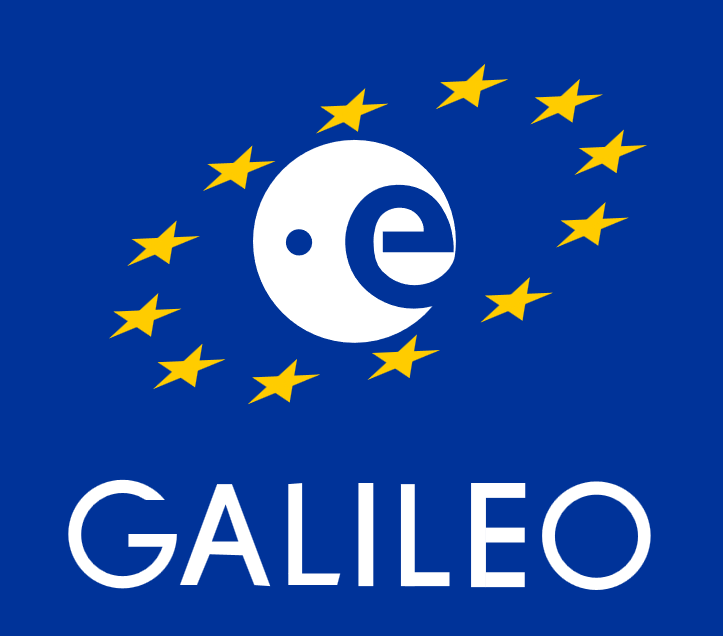

分享到: